
Creative Commons Attribution-Noncommercial-No Derivative Works 3.0
Plates 2.45-2.50: Chantry Chapels in Winchester Cathedral (Original Explanatory Account)
1 2020-06-28T18:16:07+00:00 Ariel Fried f6b6cec26c5a46c3beae9e3505bac9e8799f51de 31 81 Original Explanatory Account for Vetusta Monumenta, Plates 2.45-2.50. Written by Richard Gough. plain 2021-12-24T02:39:29+00:00 Mary-Claire Sarafianos b64b0f9cad2b567cca4c9f2022b28f5bd47876a6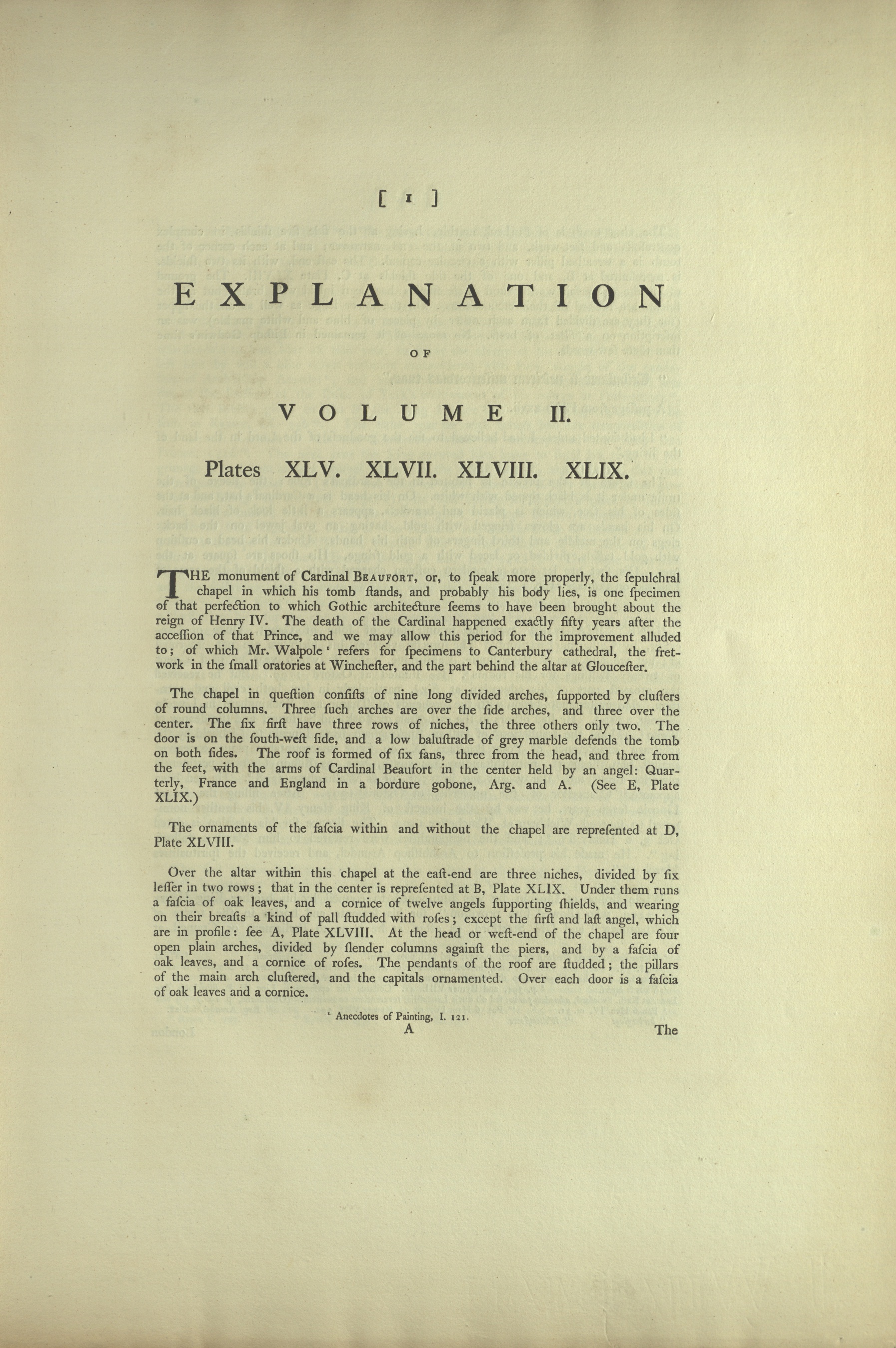
[ (Page) 1 ]
EXPLANATION OF VOLUME II. Plates XLV. XLVII. XLVIII. XLIX.
THE monument of Cardinal BEAUFORT, or, to speak more properly, the sepulchral chapel in which his tomb stands, and probably his body lies, is one specimen of that perfection to which Gothic architecture seems to have been brought about the reign of Henry IV.
Read more/less…
The death of the Cardinal happened exactly fifty years after the accession of that Prince, and we may allow this period for the improvement alluded to; of which Mr. Walpole1 refers for specimens to Canterbury cathedral, the fretwork in the small oratories at Winchester, and the part behind the altar at Gloucester.
The chapel in question consists of nine long divided arches, supported by clusters of round columns. Three such arches are over the side arches, and three over the center. The six first have three rows of niches, the three others only two. The door is on the south-west side, and a low balustrade of grey marble defends the tomb on both sides. The roof is formed of six fans, three from the head, and three from the feet, with the arms of Cardinal Beaufort in the center held by an angel: Quarterly, France and England in a bordure gobone, Arg. and A. (See E, Plate XLIX.)
The ornaments of the fascia within and without the chapel are represented at D, Plate XLVIII.
Over the altar within this chapel at the east-end are three niches, divided by six lesser in two rows; that in the center is represented at B, Plate XLIX. Under them runs a fascia of oak leaves, and a cornice of twelve angels supporting shields, and wearing on their breasts a kind of pall studded with roses; except the first and last angel, which are in profile: see A, Plate XLVIII. At the head or west-end of the chapel are four open plain arches, divided by slender columns against the piers, and by a fascia of oak leaves, and a cornice of roses. The pendants of the roof are studded; the pillars of the main arch clustered, and the capitals ornamented. Over each door is a fascia of oak leaves and a cornice.
1 Anecdotes of Painting, I. 121.

[ (Page) 2 ]
The altar tomb is of Purbeck marble, having at the side five shields in complex quatrefoils and fret-work, and two at the end narrower; and at each corner of the tomb is a wreathed pillar with a circular capital. The east-end, with its two shields, is represented at B, and one of the side shields at C, Plate XLVIII. The ground of all the quatrefoil work round these shields has been inlaid with brass, but all the shields are robbed of their eschocheons [sic].
Read more/less…
On the lower ledge as well as on the upper (for they are divided from each other by pieces of blue and white marble) was an inscription on a fillet of brass. No more of it remained in Bishop Godwin’s time than these few words,
“Tribularer si nescirem misericordias tuas,” [I would be troubled if I did not know your compassion,]
A passage from Psalm xxvii. 13:
“I have fainted unless I had believed to see the goodness of the Lord in the land of the living.”
The figure of the prelate is habited in the Cardinal’s robe: the sleeve of the tunic under it is black tipped with white. On his head is a Cardinal’s hat, and at the sides of his face, which is placid and beardless, appears a little lock of black hair. On his hands are gloves fringed with gold, having an oval jewel on the back: rings on the middle and third fingers of both hands. Under his head a cushion with gold tassels, divided or laced with a gold fringe. His shoes are square at the toes. His feet are let into a modern cushion charged with a shield of the arms of England on the face of it.
HENRY BEAUFORT was the second son of John of Gaunt, Duke of Lancaster, by Catharine Swynford. The precise year of his birth we are not informed of; but we find him at Peter-house, Cambridge, 1388, in which year he paid a rent of twenty shillings for his rooms2. He studied at Oxford 1397. But he received the greatest part of his education at Aix3, particularly in law both civil and common. His preferments began with the prebends of Thame and Bockingham in Lincoln diocese, 13894. He had others in the cathedrals of York and Salisbury, and the deanry of Wells5. Upon the translation6 of Bishop Bockingham from Lincoln to Lichfield by the arbitrary interference of Pope Boniface IX. on some unaccountable pique conceived against him, Beaufort, notwithstanding his youth, was, as Bishop Godwin pertinently remarks, thrust into7 the vacant see in 1397, or as Walsingham 13988. He had been appointed Chancellor of the university of Oxford 1397. After filling the see of Lincoln seven years, he was by the interest of King Henry IV. his brother nominated to succeed Wickham at Winchester 1404. The licence for his election is dated Oct 3, 6 Henry IV.9; and the temporalities were restored to him March 4 following10. He made his profession to Archbishop Arundel, and received spiritualities March 1811.
While Bishop of Lincoln he was summoned to council by his brother King Henry IV. 1403, who allowed him provision12 for his servants and horses in the towns of Walthamstow13 and Old Stratford, as often as he came to Parliament or Council at
2 Richardson, note on Godwin de praes. p. 131, and MS. note Wren.
3 Aquisgrani.
4 Willis.
5 Ib. I. 53.
6 This, in the instrument of restitution of the temporalities to Beaufort, is called absolving him from his obligations to the church. Rymer VIII, 41, as in other instances.
7 Vidit se ingeri. [He saw himself brought in.]
8 p. 394, and Rymer VIII. 41. Collatus suit episcopatus Linc. H.B. filio Johis duc. Lanc. et Kath. Swinford, admodum parvo, sed ob ducis Lancastriae reverentiam et amorem. (Otterborne, p. 196.) [The bishopric of Linc(oln) was conferred upon H(enry) B(eaufort), son of John duke of Lanc(aster) and Cath(erine) Swinford, notwithstanding his youth, but on account of the high regard and love of the duke of Lancaster (i.e. for him).]
9 Pat. 6 Hen. IV. m. 31.
10 Pat. 6 Hen. IV, m. 31. Rymer VIII. 392.
11 Reg. Arundel, fol. 28.
12 herbergiage
13 Woltomstowe.
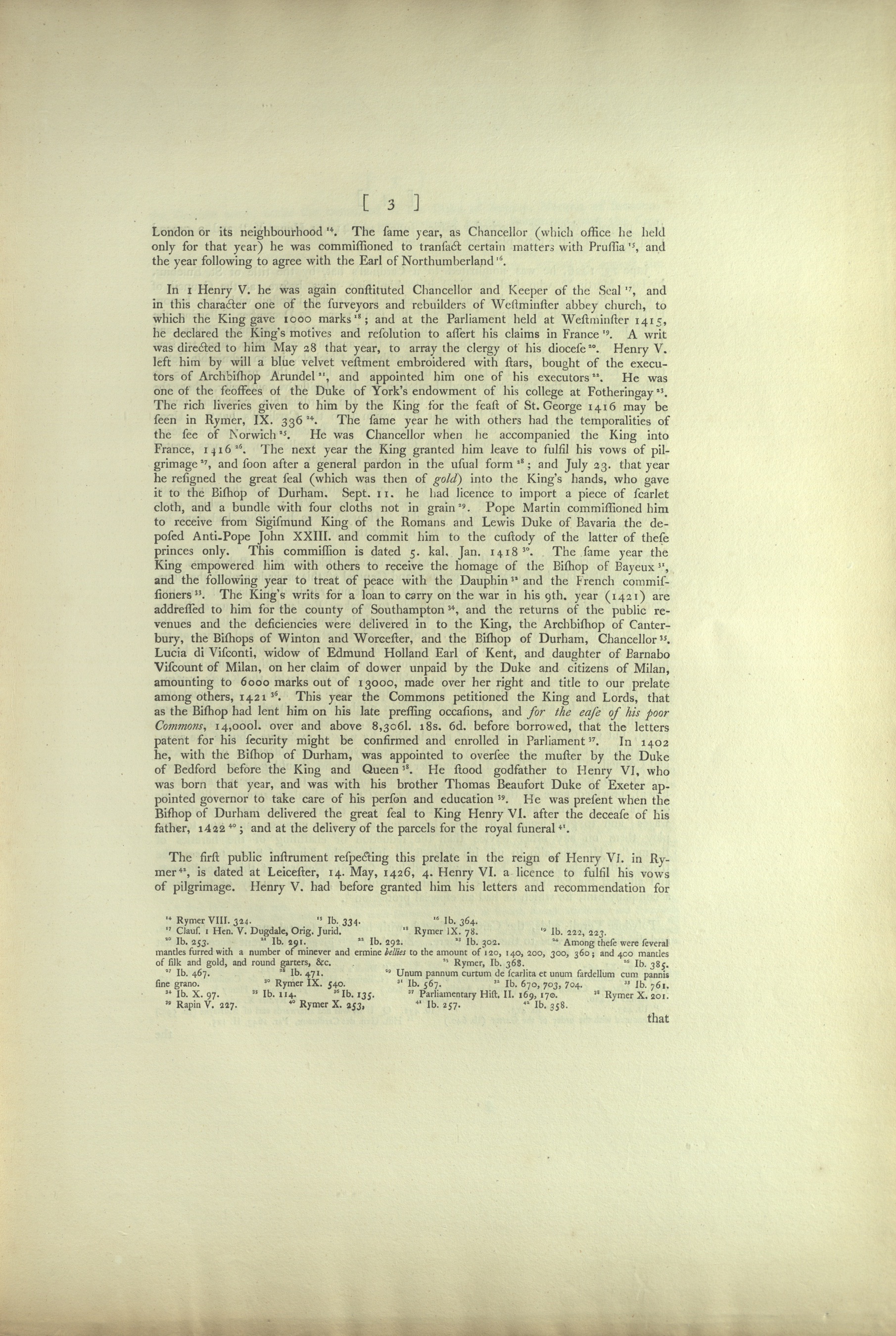
[ (Page) 3 ]
London or its neighbourhood14. The same year, as Chancellor (which office he held only for that year) he was commissioned to transact certain matters with Prussia15, and the year following to agree with the Earl of Northumberland16.
Read more/less…
In 1 Henry V. he was again constituted Chancellor and Keeper of the Seal17, and in this character one of the surveyors and rebuilders of Westminster abbey church, to which the King gave 1000 marks18; and at the Parliament held at Westminster 1415, he declared the King’s motives and resolution to assert his claims in France19. A writ was directed to him May 28 that year, to array the clergy of his diocese20. Henry V. left him by will a blue velvet vestment embroidered with stars, bought of the executors of Archbishop Arundel21, and appointed him one of his executors22. He was one of the feoffees of the Duke of York’s endowment of his college at Fotheringay23. The rich liveries given to him by the King for the feast of St. George 1416 may be seen in Rymer, IX. 33624. The same year he with others had the temporalities of the see of Norwich25. He was Chancellor when he accompanied the King into France, 141626. The next year the King granted him leave to fulfil his vows of pilgrimage27, and soon after a general pardon in the usual form28; and July 23. that year he resigned the great seal (which was then of gold) into the King’s hands, who gave it to the Bishop of Durham. Sept. 11. he had licence to import a piece of scarlet cloth, and a bundle with four cloths not in grain29. Pope Martin commissioned him to receive from Sigismund King of the Romans and Lewis Duke of Bavaria the deposed Anti-Pope John XXIII. and commit him to the custody of the latter of these princes only. This commission is dated 5. kal. Jan. 141830. The same year the King empowered him with others to receive the homage of the Bishop of Bayeux31, and the following year to treat of peace with the Dauphin32 and the French commissioners33. The King’s writs for a loan to carry on the war in his 9th. year (1421) are addressed to him for the county of Southampton34, and the returns of the public revenues and the deficiencies were delivered in to the King, the Archbishop of Canterbury, the Bishops of Winton and Worcester, and the Bishop of Durham, Chancellor35. Lucia di Visconti, widow of Edmund Holland Earl of Kent, and daughter of Barnabo Viscount of Milan, on her claim of dower unpaid by the Duke and citizens of Milan, amounting to 6000 marks out of 13000, made over her right and title to our prelate among others, 142136. This year the Commons petitioned the King and Lords, that as the Bishop had lent him on his late pressing occasions, and for the ease of his poor Commons, 14,000l. over and above 8,306l. 18s. 6d. before borrowed, that the letters patent for his security might be confirmed and enrolled in Parliament37. In 1402 he, with the Bishop of Durham, was appointed to oversee the muster by the Duke of Bedford before the King and Queen38. He stood godfather to Henry VI, who was born that year, and was with his brother Thomas Beaufort Duke of Exeter appointed governor to take care of his person and education39. He was present when the Bishop of Durham delivered the great seal to King Henry VI. after the decease of his father, 142240; and at the delivery of the parcels for the royal funeral41.
The first public instrument respecting this prelate in the reign of Henry VI. in Rymer42, is dated at Leicester, 14. May, 1426, 4. Henry VI. a licence to fulfil his vows of pilgrimage. Henry V. had before granted him his letters and recommendation for
14 Rymer VIII. 324.
15 Ib. 334.
16 Ib. 364.
17 Claus. 1 Hen. V. Dugdale, Orig. Jurid.
18 Rymer IX. 78.
19 Ib. 222, 223.
20 Ib. 253.
21 Ib. 291.
22 Ib. 292.
23 Ib. 302.
24 Among these were several mantles furred with a number of minever and ermine bellies to the amount of 120, 140, 200, 300, 360; and 400 mantles of silk and gold, and round garters, &c.
25 Rymer, Ib. 368.
26 Ib. 385.
27 Ib. 467.
28 Ib. 471.
29 Unum pannum curtum de scarlita et unum fardellum cum pannis fine grano. [A short piece of scarlet cloth and a bundle with pieces of cloth without grain.]
30 Rymer IX. 540.
31 Ib. 567.
32 Ib. 670, 703, 704.
33 Ib. 761.
34 Ib. X. 97.
35 Ib. 114.
36 Ib. 135.
37 Parliamentary Hist. II. 169, 170.
38 Rymer X. 201.
39 Rapin V. 227.
40 Rymer X. 253[.]
41 Ib. 257.
42 Ib. 358.
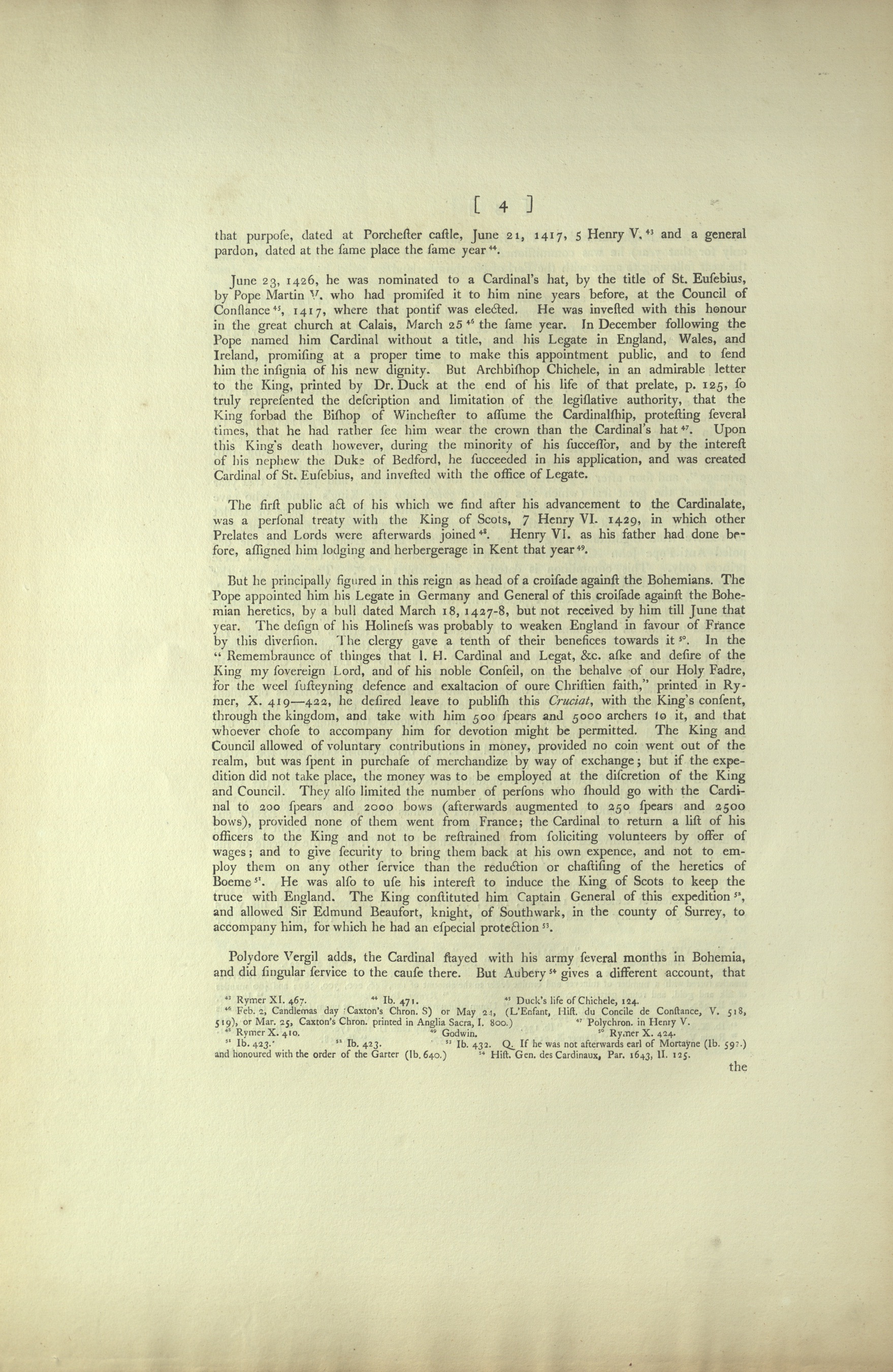
[ (Page) 4 ]
that purpose, dated at Porchestser castle, June 21, 1417, 5 Henry V.43 and a general pardon, dated at the same place the same year44.
Read more/less…
June 23, 1426 he was nominated to a Cardinal’s hat, by the title of St. Eusebius, by Pope Martin V. who had promised it to him nine years before, at the Council of Constance45, 1417, where the pontif was elected. He was invested with this honour in the great church at Calais, March 2546 the same year. In December following the Pope named him Cardinal without a title, and his Legate in England, Wales, and Ireland, promising at a proper time to make this appointment public, and to send him the insignia of his new dignity. But Archbishop Chichele, in an admirable letter to the King, printed by Dr. Duck at the end of his life of that prelate, p. 125, so truly represented the description and limitation of the legislative authority, that the King forbad the Bishop of Winchester to assume the Cardinalship, protesting several times, that he had rather see him wear the crown than the Cardinal’s hat47. Upon this King’s death however, during the minority of his successor, and by the interest of his nephew the Duke of Bedford, he succeeded in his application, and was created Cardinal of St. Eusebius, and invested with the office of Legate.
The first public act of his which we find after his advancement to the Cardinalate, was a personal treaty with the King of Scots, 7 Henry VI. 1429, in which other Prelates and Lords were afterwards joined48. Henry VI. as his father had done before, assigned him lodging and herbergerage in Kent that year49.
But he principally figured in this reign as head of a croisade against the Bohemians. The Pope appointed him his Legate in Germany and General of this croisade against the Bohemian heretics, by a bull dated March 18, 1427-8, but not received by him till June that year. The design of his Holiness was probably to weaken England in favour of France by this diversion. The clergy gave a tenth of their benefices towards it50. In the “Remembraunce of things that 1. H. Cardinal and Legat, &c. aske and desire of the King my sovereign Lord, and of his noble Conseil, on the behalve of our Holy Fadre, for the weel susteyning defence and exaltacion of oure Christien faith,” printed in Rymer, X. 419—422, he desired leave to publish this Cruciat, with the King’s consent, through the kingdom, and take with him 500 spears and 5000 archers to it, and that whoever chose to accompany him for devotion might be permitted. The King and Council allowed of voluntary contributions in money, provided no coin went out of the realm, but was spent in purchase of merchandize by way of exchange; but if the expedition did not take place, the money was to be employed at the discretion of the King and Council. They also limited the number of persons who should go with the Cardinal to 200 spears and 2000 bows (afterwards augmented to 250 spears and 2500 bows), provided none of them went from France; the Cardinal to return a list of his officers to the King and not to be restrained from soliciting volunteers by offer of wages; and to give security to bring them back at his own expence, and not to employ them on any other service than the reduction or chastising of the heretics of Boeme51. He was also to use his interest to induce the King of Scots to keep the truce with England. The King constituted him Captain General of this expedition52, and allowed Sir Edmund Beaufort, knight, of Southwark, in the county of Surrey, to accompany him, for which he had an especial protection53.
Polydore Vergil adds, the Cardinal stayed with his army several months in Bohemia, and did singular service to the cause there. But Aubery54 gives a different account, that
43 Rymer XI. 467.
44 Ib. 471.
45 Duck’s life of Chichele, 124.
46 Feb. 2, Candlemas day [(]Caxton’s Chron. S) or May 24, (L’Enfant, Hist. du Concile de Constance, V. 518, 519), or Mar. 25, [(]Caxton’s Chron. printed in Anglia Sacra, I. 800.)
47 Polychron. in Henry V.
48 Rymer X. 410.
49 Godwin.
50 Rymer X. 424.
51 Ib. 423.
52 Ib. 423.
53 Ib. 432. Q. If he was not afterwards earl of Mortayne (Ib. 597.) and honoured with the order of the Garter (Ib. 640.)
54 Hist. Gen. des Cardinaux, Par. 1643, II. 125.
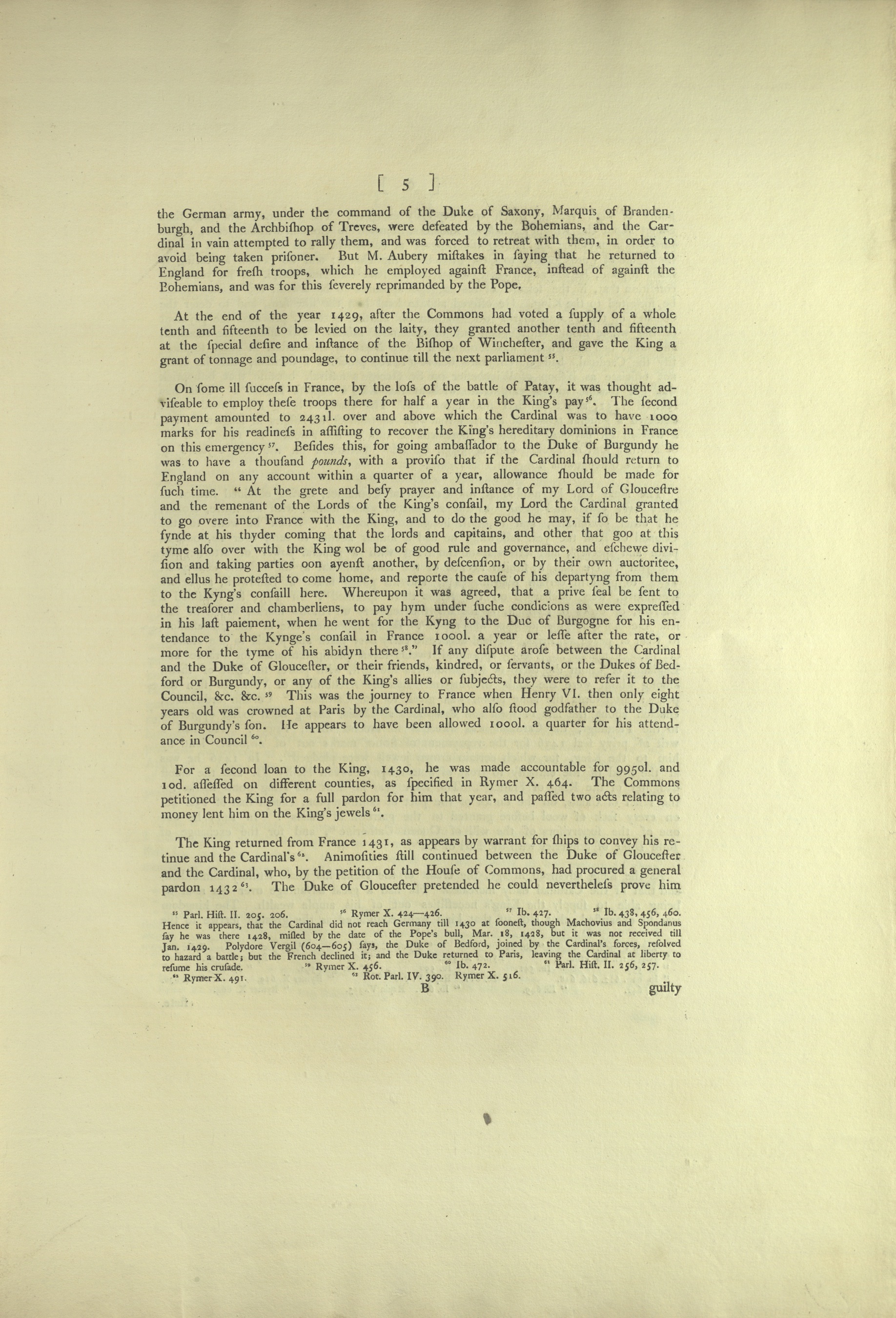
[ (Page) 5 ]
the German army, under the command of the Duke of Saxony, Marquis of Brandenburgh, and the Archbishop of Treves, were defeated by the Bohemians, and the Cardinal in vain attempted to rally them, and was forced to retreat with them, in order to avoid being taken prisoner. But M. Aubery mistakes in saying that he returned to England for fresh troops, which he employed against France, instead of against the Bohemians, and was for this severely reprimanded by the Pope.
Read more/less…
At the end of the year 1429, after the Commons had voted a supply of a whole tenth and fifteenth to be levied on the laity, they granted another tenth and fifteenth at the special desire and instance of the Bishop of Winchester, and gave the King a grant of tonnage and poundage, to continue till the next parliament55.
On some ill success in France, by the loss of the battle of Patay, it was thought adviseable to employ these troops there for half a year in the King’s pay56. The second payment amounted to 2431l. over and above which the Cardinal was to have 1000 marks for his readiness in assisting to recover the King’s hereditary dominions in France on this emergency57. Besides this, for going ambassador to the Duke of Burgundy he was to have a thousand pounds, with a proviso that if the Cardinal should return to England on any account within a quarter of a year, allowance should be made for such time. “At the grete and besy prayer and instance of my Lord of Gloucestre and the remenant of the Lords of the King’s consail, my Lord the Cardinal granted to go overe into France with the King, and to do the good he may, if so be that he fynde at his thyder coming that the lords and capitains, and other that goo at this tyme also over with the King wol be of good rule and governance, and eschewe division and taking parties oon ayenst another, by descension, or by their own auctoritee, and ellus he protested to come home, and reporte the cause of his departyng from them to the Kyng’s consaill here. Whereupon it was agreed, that a prive seal be sent to the treasorer and chamberliens, to pay hym under suche condicions as were expressed in his last paiement, when he went for the Kyng to the Duc of Burgogne for his entendance to the Kynge’s consail in France 1000l. a year or lesse after the rate, or more for the tyme of his abidyn there58.” If any dispute arose between the Cardinal and the Duke of Gloucester, or their friends, kindred, or servants, or the Dukes of Bedford or Burgundy, or any of the King’s allies or subjects, they were to refer it to the Council, &c. &c.59 This was the journey to France when Henry VI. then only eight years old was crowned at Paris by the Cardinal, who also stood godfather to the Duke of Burgundy’s son. He appears to have been allowed 1000l. a quarter for his attendance in Council60.
For a second loan to the King, 1430, he was made accountable for 9950l. and 10d. assessed on different counties, as specified in Rymer X. 464. The Commons petitioned the King for a full pardon for him that year, and passed two acts relating to money lent him on the King’s jewels61.
The King returned from France 1431, as appears by warrant for ships to convey his retinue and the Cardinal’s62. Animosities still continued between the Duke of Gloucester and the Cardinal, who, by petition of the House of Commons, had procured a general pardon 143263. The Duke of Gloucester pretended he could nevertheless prove him
55 Parl. Hist. II. 205. 206.
56 Rymer X. 424—426.
57 Ib. 427.
58 Ib. 438, 456, 460. Hence it appears, that the Cardinal did not reach Germany till 1430 at soonest, though Machovius and Spondanus say he was there 1428, misled by the date of the Pope’s bull, Mar. 18, 1428, but it was not received till Jan. 1429. Polydore Vergil (604—605) says, the Duke of Bedford, joined by the Cardinal’s forces, resolved to hazard a battle; but the French declined it; and the Duke returned to Paris, leaving the Cardinal at liberty to resume his crusade.
59 Rymer X. 456.
60 Ib. 472.
61 Parl. Hist. II. 256, 257.
62 Rymer X. 491.
63 Rot. Parl. IV. 390. Rymer X. 516.
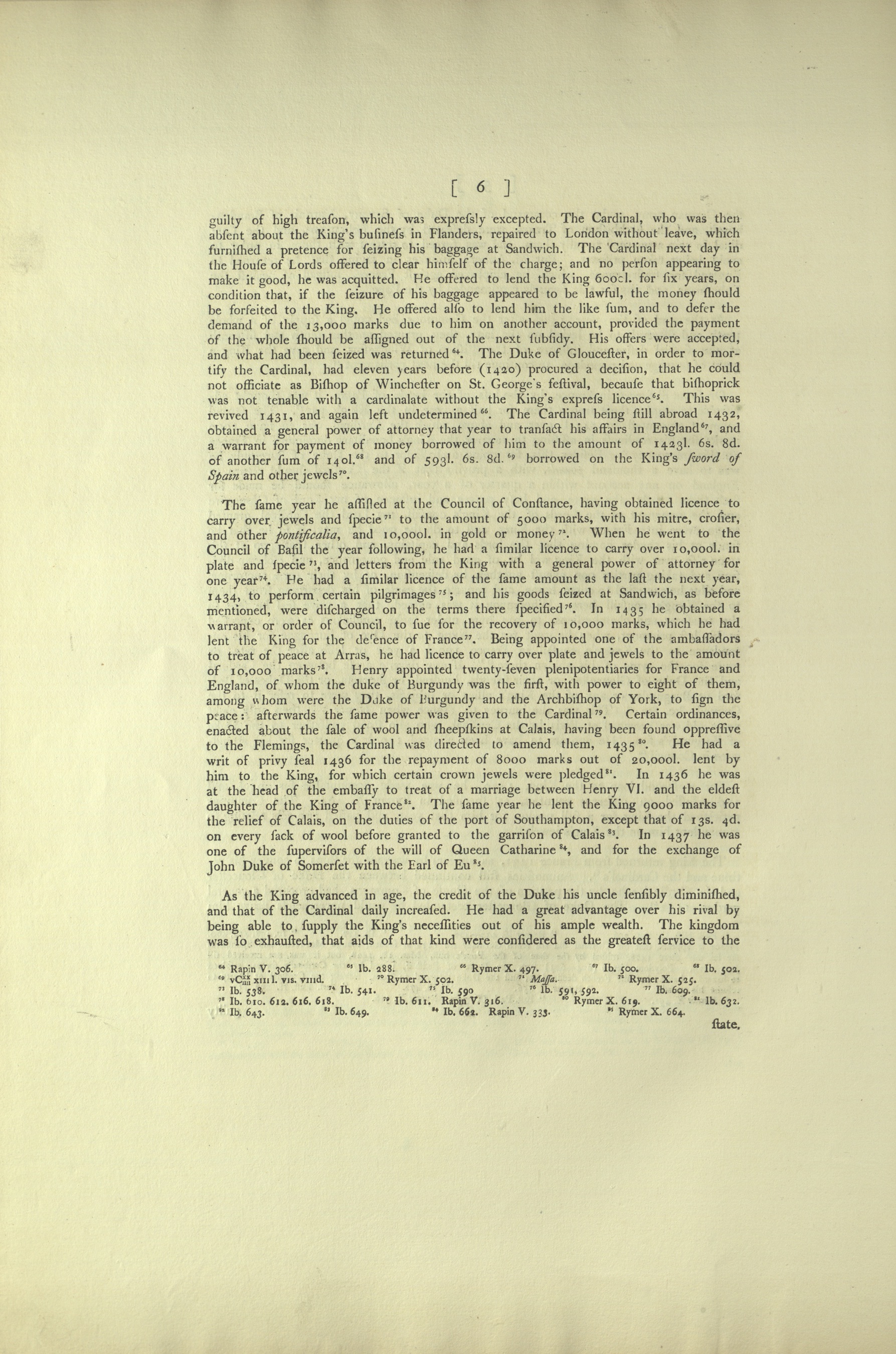
[ (Page) 6 ]
guilty of high treason, which was expressly excepted. The Cardinal, who was then absent about the King’s business in Flanders, repaired to London without leave, which furnished a pretence for seizing his baggage at Sandwich. The Cardinal next day in the House of Lords offered to clear himself of the charge; and no person appearing to make it good, he was acquitted.
Read more/less…
He offered to lend the King 6000l. for six years, on condition that, if the seizure of his baggage appeared to be lawful, the money should be forfeited to the King. He offered also to lend him the like sum, and to defer the demand of the 13,000 marks due to him on another account, provided payment of the whole should be assigned out of the next subsidy. His offers were accepted, and what had been seized was returned64. The Duke of Gloucester, in order to mortify the Cardinal, had eleven years before (1420) procured a decision, that he could not officiate as Bishop of Winchester on St. George’s festival, because that bishoprick was not tenable with a cardinalate without the King’s express licence65. This was revived 1431, and again left undetermined66. The Cardinal being still abroad 1432, obtained a general power of attorney that year to transact his affairs in England67, and a warrant for payment of money borrowed of him to the amount of 1423l. 6s. 8d. of another sum of 140l.68 and of 593l. 6s. 8d.69 borrowed on the King’s sword of Spain and other jewels70.
The same year he assisted at the Council of Constance, having obtained licence to carry over jewels and specie71 to the amount of 5000 marks, with his mitre, crosier, and other pontificalia, and 10,000l. in gold or money72. When he went to the Council of Basil the year following, he had a similar licence to carry over 10,000l. in plate and specie73, and letters from the King with a general power of attorney for one year74. He had a similar licence of the same amount as the last the next year, 1434, to perform certain pilgrimages75; and his goods seized at Sandwich, as before mentioned, were discharged on the terms there specified76. In 1435 he obtained a warrant, or order of Council, to sue for the recovery of 10,000 marks, which he had lent the King for the defence of France77. Being appointed one of the ambassadors to treat of peace at Arras, he had licence to carry over plate and jewels to the amount of 10,000 marks78. Henry appointed twenty-seven plenipotentiaries for France and England, of whom the duke of Burgundy was the first, with power to eight of them, among whom were the Duke of Burgundy and the Archbishop of York, to sign the peace: afterwards the same power was given to the Cardinal79. Certain ordinances, enacted about the sale of wool and sheepskins at Calais, having been found oppressive to the Flemings, the Cardinal was directed to amend them, 143580. He had a writ of privy seal 1436 for the repayment of 8000 marks out of 20,000l. lent by him to the King, for which certain crown jewels were pledged81. In 1436 he was at the head of the embassy to treat of a marriage between Henry VI. and the eldest daughter of the King of France82. The same year he lent the King 9000 marks for the relief of Calais, on the duties of the port of Southampton, except that of 13s. 4d. on every sack of wool before granted to the garrison of Calais83. In 1437 he was one of the supervisors of the will of Queen Catharine84, and for the exchange of John Duke of Somerset with the Earl of Eu85.
64 Rapin V. 306.
65 Ib. 288.
66 Rymer X. 497.
67 Ib. 500.
68 Ib. 502.
69 vCXXIIII xiiil. vis. viiid.
70 Rymer X. 502.
71 Massa.
72 Rymer X. 525.
73 Ib. 538.
74 Ib. 541.
75 Ib. 590.
76 Ib. 591, 592.
77 Ib. 609.
78 Ib. 610. 612. 616. 618.
79 Ib. 611. Rapin V. 316.
80 Rymer X. 619.
81 Ib. 632.
82 Ib. 643.
83 Ib. 649.
84 Ib. 662. Rapin V. 333.
85 Rymer X. 664.
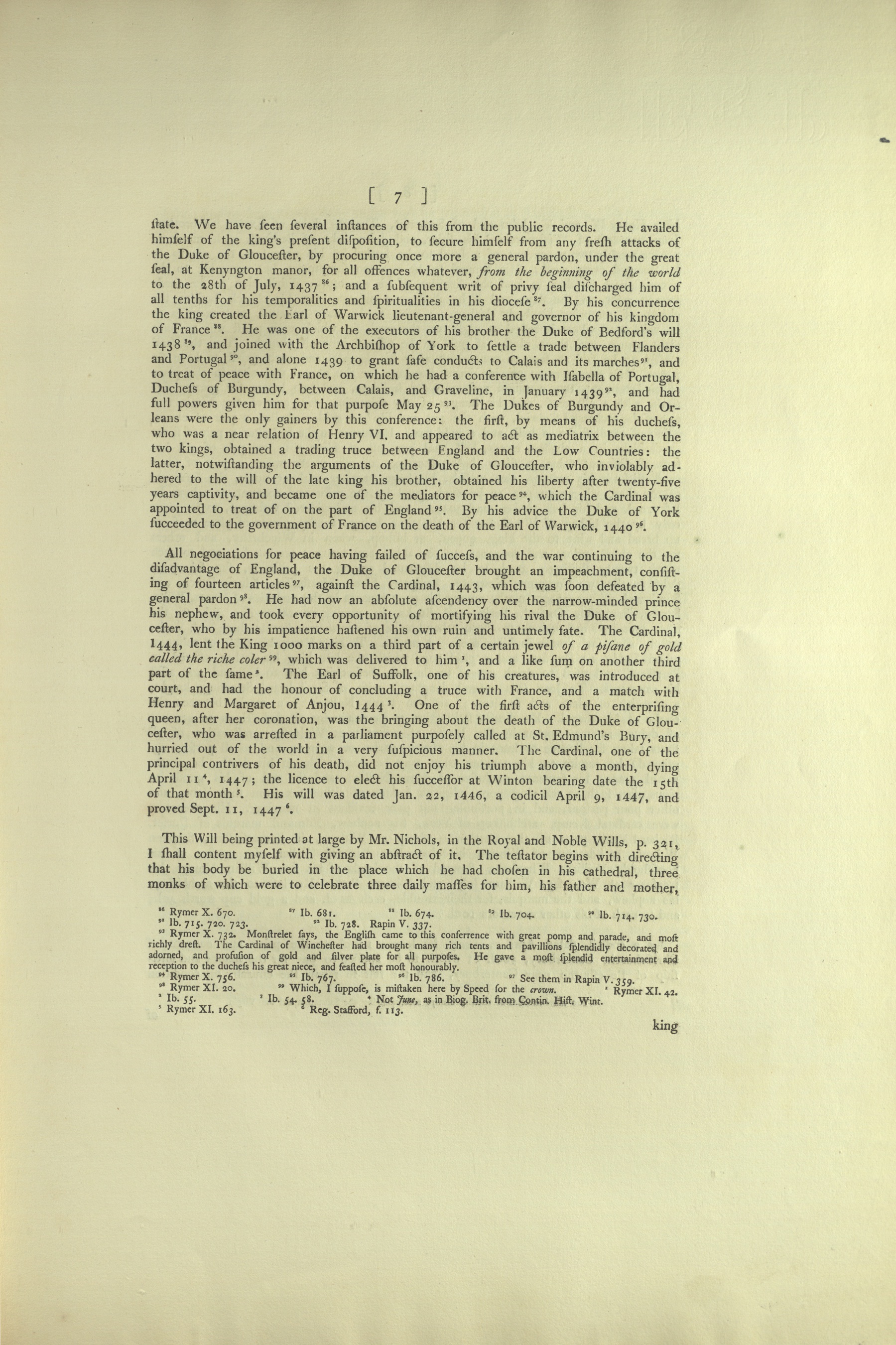
[ (Page) 7 ]
state. We have seen instances of this from the public records. He availed himself of the king’s present disposition, to secure himself from any fresh attacks of the Duke of Gloucester, by procuring once more a general pardon, under the great seal, at Kenyngton manor, for all offences whatever, from the beginning of the world to the 28th of July 143786; and a subsequent writ of privy seal discharged him of all tenths for his temporalities and spiritualities in his diocese87.
Read more/less…
By his concurrence the king created the Earl of Warwick lieutenant-general and governor of his kingdom of France88. He was one of the executors of his brother the Duke of Bedford’s will 143889, and joined with the Archbishop of York to settle a trade between Flanders and Portugal90, and alone 1439 to grant safe conducts to Calais and its marches91, and to treat of peace with France, on which he had a conference with Isabella of Portugal, Duchess of Burgundy, between Calais, and Graveline, in January 143992, and had full powers given him for that purpose May 2593. The Dukes of Burgundy and Orleans were the only gainers by this conference: the first, by means of his duchess, who was a near relation of Henry VI. and appeared to act as mediatrix between the two kings, obtained a trading truce between England and the Low Countries: the latter, notwistanding the arguments of the Duke of Gloucester, who inviolably adhered to the will of the late king his brother, obtained his liberty after twenty-five years captivity, and became one of the mediators for peace94, which the Cardinal was appointed to treat of on the part of England95. By his advice the Duke of York succeeded to the government of France on the death of the Earl of Warwick, 144096.
All negociations for peace having failed of success, and the war continuing to the disadvantage of England, the Duke of Gloucester brought an impeachment, consisting of fourteen articles97, against the Cardinal, 1443, which was soon defeated by a general pardon98. He had now an absolute ascendency over the narrow-minded prince his nephew, and took every opportunity of mortifying his rival the Duke of Gloucester, who by his impatience hastened his own ruin and untimely fate. The Cardinal, 1444, lent the King 1000 marks on a third part of a certain jewel of a pisane of gold called the riche coler99, which was delivered to him1, and a like sum on another third part of the same2. The Earl of Suffolk, one of his creatures, was introduced at court, and had the honour of concluding a truce with France, and a match with Henry and Margaret of Anjou, 14443. One of the first acts of the enterprising queen, after her coronation, was the bringing about the death of the Duke of Gloucester, who was arrested in a parliament purposely called at St. Edmund’s Bury, and hurried out of the world in a very suspicious manner. The Cardinal, one of the principal contrivers of his death, did not enjoy his triumph above a month, dying April 114, 1447; the licence to elect his successor at Winton bearing date the 15th of that month5. His will was dated Jan. 22, 1446, a codicil April 9, 1447, and proved Sept. 11, 14476.
This Will being printed at large by Mr. Nichols, in the Royal and Noble Wills, p. 321, I shall content myself with giving an abstract of it. The testator begins with directing that his body be buried in the place which he had chosen in his cathedral, three monks of which were to celebrate three daily masses for him, his father and mother,
86 Rymer X. 670.
87 Ib. 681.
88 Ib. 674.
89 Ib. 704.
90 Ib. 714. 730.
91 Ib. 715. 720. 723.
92 Ib. 728. Rapin V. 337.
93 Rymer X. 732. Monstrelet says, the English came to this conferrence with great pomp and parade, and most richly drest. The Cardinal of Winchester had brought many rich tents and pavillions splendidly decorated and adorned, and profusion of gold and silver plate for all purposes. He gave a most splendid entertainment and reception to the duchess his great niece, and feasted her most honourably.
94 Rymer X. 756.
95 Ib. 767.
96 Ib. 786.
97 See them in Rapin V. 359.
98 Rymer XI. 20.
99 Which, I suppose, is mistaken here by Speed for the crown.
1 Rymer XI. 42.
2 Ib. 55.
3 Ib. 54. 58.
4 Not June, as in Biog. Brit. from Contin. Hist. Wint.
5 Rymer XI. 163.
6 Reg. Stafford, f. 113.
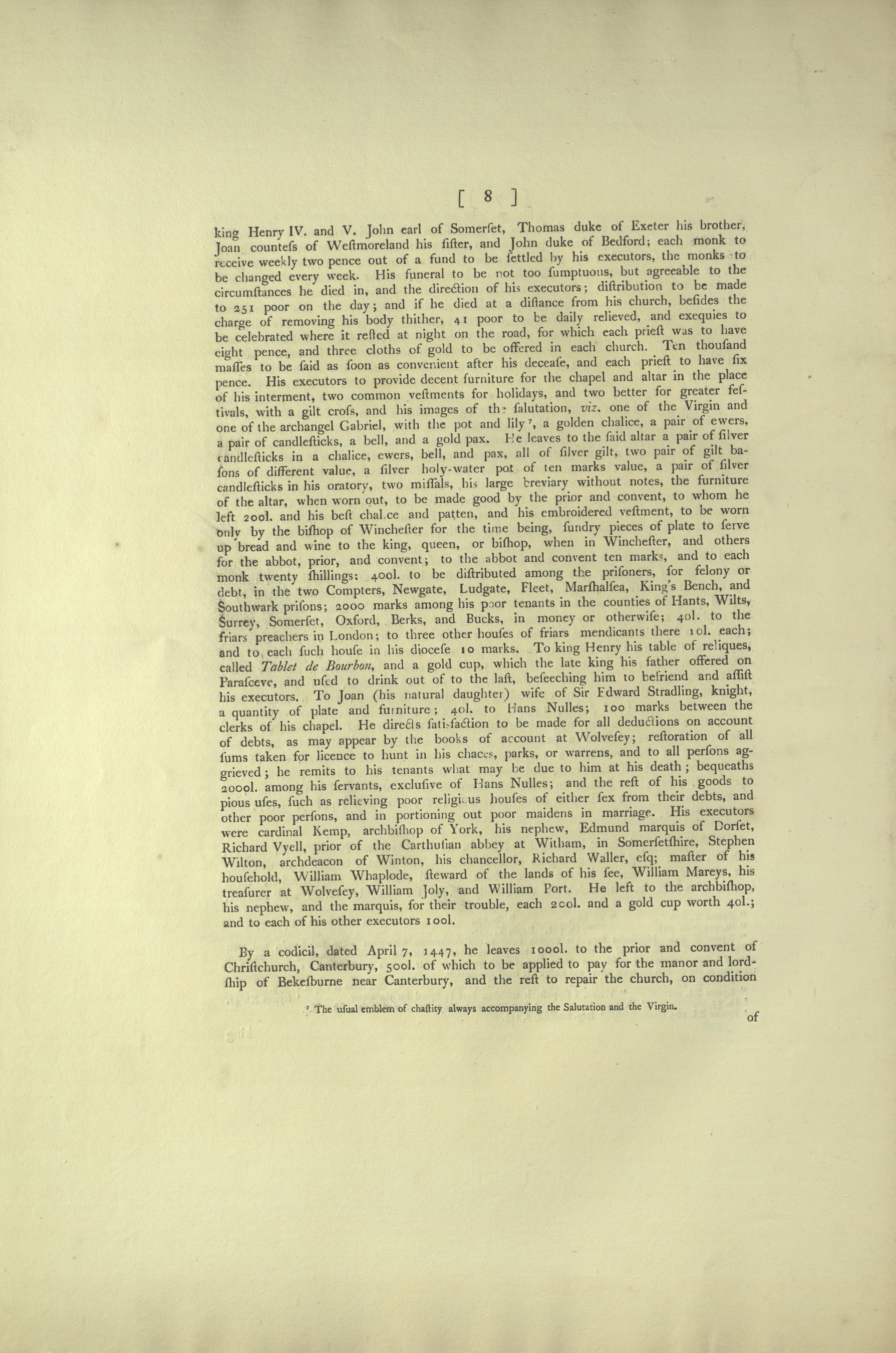
[ (Page) 8 ]
king Henry IV. and V. John earl of Somerset, Thomas duke of Exeter his brother, Joan countess of Westmoreland his sister, and John duke of Bedford; each monk to receive weekly two pence out of a fund to be settled by his executors, the monks to be changed every week.
Read more/less…
His funeral to be not too sumptuous, but agreeable to the circumstances he died in, and the direction of his executors; distribution to be made to 251 poor on the day; and if he died at a distance from his church, besides the charge of removing his body thither, 41 poor to be daily relieved, and exequies to be celebrated where it rested at night on the road, for which each priest was to have eight pence, and three cloths of gold to be offered in each church. Ten thousand masses to be said as soon as convenient after his decease, and each priest to have six pence. His executors to provide decent furniture for the chapel and altar in the place of his interment, two common vestments for holidays, and two better for greater festivals, with a gilt cross, and his images of the salutation, viz. one of the Virgin and one of the archangel Gabriel, with the pot and lily7, a golden chalice, a pair of ewers, a pair of candlesticks, a bell, and a gold pax. He leaves to the said altar a pair of silver candlesticks in a chalice, ewers, bell, and pax, all of silver gilt, two pair of gilt basons of different value, a silver holy-water pot of ten marks value, a pair of silver candlesticks in his oratory, two missals, his large breviary without notes, the furniture of the altar, when worn out, to be made good by the prior and convent, to whom he left 200l. and his best chal[i]ce and patten, and his embroidered vestment, to be worn only by the bishop of Winchester for the time being, sundry pieces of plate to serve up bread and wine to the king, queen, or bishop, when in Winchester, and others for the abbot, prior, and convent; to the abbot and convent ten marks, and to each monk twenty shillings: 400l. to be distributed among the prisoners, for felony or debt, in the two Compters, Newgate, Ludgate, Fleet, Marshalsea, King’s Bench, and Southwark prisons; 2000 marks among his poor tenants in the counties of Hants, Wilts, Surrey, Somerset, Oxford, Berks, and Bucks, in money or otherwise; 40l. to the friars preachers in London; to three other houses of friars mendicants there 10l. each; and to each such house in his diocese 10 marks. To king Henry his table of reliques, called Tablet de Bourbon, and a gold cup, which the late king his father offered on Parasceve, and used to drink out of to the last, beseeching him to befriend and assist his executors. To Joan (his natural daughter) wife of Sir Edward Stradling knight, a quantity of plate and furniture; 40l. to Hans Nulles; 100 marks between the clerks of his chapel. He directs satisfaction to be made for all deductions on account of debts, as may appear by the books of account at Wolvesey; restoration of all sums taken for licence to hunt in his chaces, parks, or warrens, and to all persons aggrieved; he remits to his tenants what may be due to him at his death; bequeaths 2000l. among his servants, exclusive of Hans Nulles; and the rest of his goods to pious uses, such as relieving poor religious houses of either sex from their debts, and other poor persons, and in portioning out poor maidens in marriage. His executors were cardinal Kemp, archbishop of York, his nephew, Edmund marquis of Dorset, Richard Vyell, prior of the Carthusian abbey at Witham, in Somersetshire, Stephen Wilton, archdeacon of Winton, his chancellor, Richard Waller, esq; master of his household, William Whaplode, steward of the lands of his see, William Mareys, his treasurer at Wolvesey, William Joly, and William Port. He left to the archbishop, his nephew, and the marquis, for their trouble, each 200l. and a gold cup worth 40l.; and to each of his other executors 100l.
By a codicil, dated April 7, 1447, he leaves 1000l. to the prior and convent of Christchurch, Canterbury, 500l. of which to be applied to pay for the manor and lordship of Bekesburne near Canterbury, and the rest to repair the church on condition
7 The usual emblem of chastity always accompanying the Salutation and the Virgin.
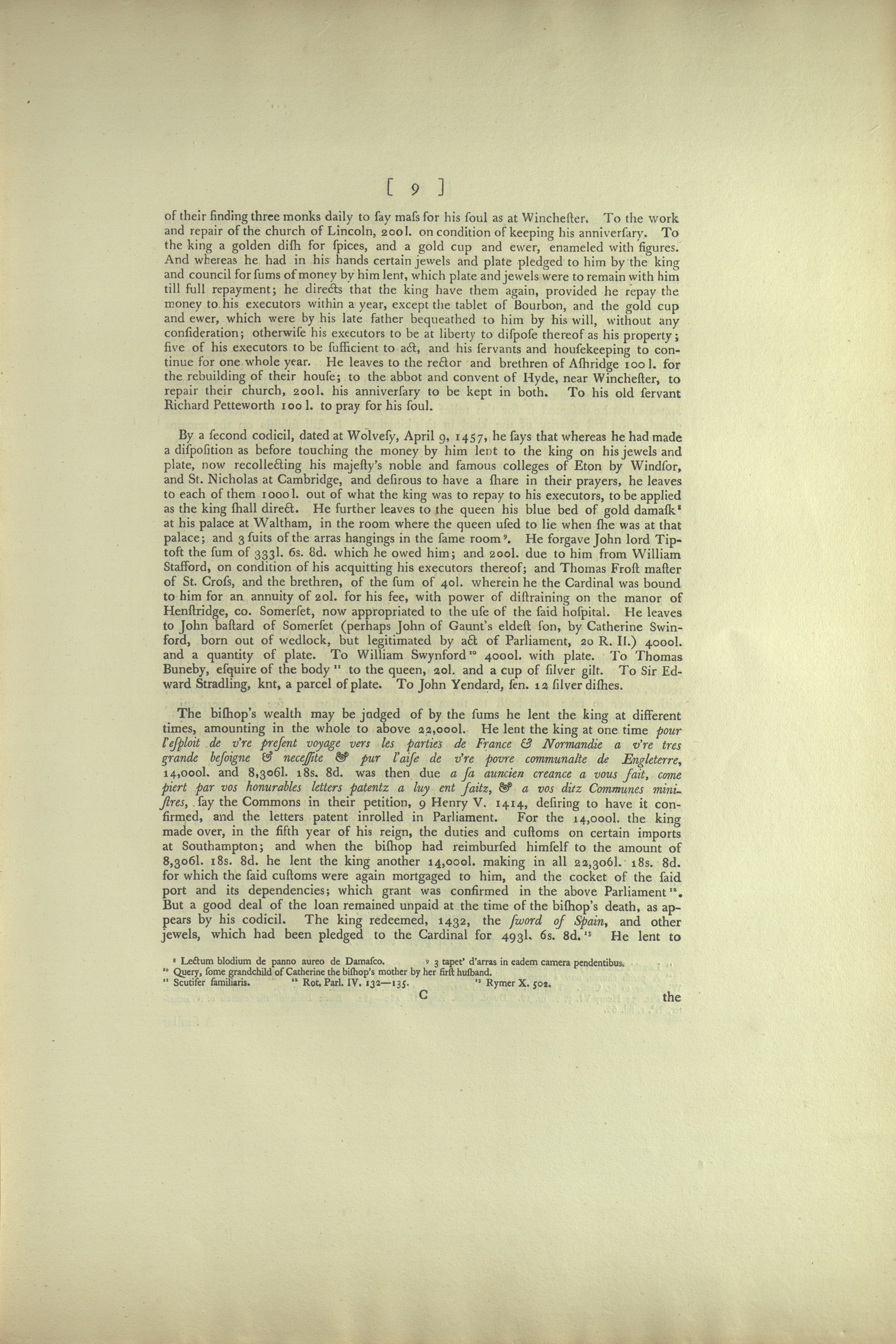
[ (Page) 9 ]
of their finding three monks daily to say mass for his soul as at Winchester. To the work and repair of the church of Lincoln, 200l. on condition of keeping his anniversary. To the king a golden dish for spices, and a gold cup and ewer, enameled with figures.
Read more/less…
And whereas he had in his hands certain jewels and plate pledged to him by the king and council for sums of money by him lent, which plate and jewels were to remain with him till full repayment; he directs that the king have them again, provided he repay the money to his executors within a year, except the tablet of Bourbon, and the gold cup and ewer, which were by his late father bequeathed to him by his will, without any consideration; otherwise his executors to be at liberty to dispose thereof as his property; five of his executors to be sufficient to act, and his servants and housekeeping to continue for one whole year. He leaves to the rector and brethren of Ashridge 100l. for the rebuilding of their house; to the abbot and convent of Hyde, near Winchester, to repair their church, 200l. his anniversary to be kept in both. To his old servant Richard Petteworth 100l. to pray for his soul.
By a second codicil, dated at Wolvesy, April 9, 1457, he says that whereas he had made a disposition as before touching the money by him lent to the king on his jewels and plate, now recollecting his majesty’s noble and famous colleges of Eton by Windsor, and St. Nicholas at Cambridge, and desirous to have a share in their prayers, he leaves to each of them 1000l. out of what the king was to repay his executors, to be applied as the king shall direct. He further leaves to the queen his blue bed of gold damask8 at his palace at Waltham, in the room where the queen used to lie when she was at that palace; and 3 suits of the arras hangings in the same room9. He forgave John lord Tiptoft the sum of 333l. 6s. 8d. which he owed him; and 200l. due to him from William Stafford, on condition of his acquitting his executors thereof; and Thomas Frost master of St. Cross, and the brethren, of the sum of 40l. wherein he the Cardinal was bound to him for an annuity of 20l. for his see, with power of distraining on the manor of Henstridge, co. Somerset, now appropriated to the use of the said hospital. He leaves to John bastard of Somerset (perhaps John of Gaunt’s eldest son, by Catherine Swinford, born out of wedlock, but legitimated by act of Parliament, 20 R. II.) 4000l. and a quantity of plate. To William Swynford10 4000l. with plate. To Thomas Buneby, esquire of the body11 to the queen, 20l. and a cup of silver gilt. To Sir Edward Stradling, knt, a parcel of plate. To John Yendard, sen. 12 silver dishes.
The bishop’s wealth may be judged of by the sums he lent the king at different times, amounting in the whole to above 22,000l. He lent the king at one time pour l’esploit de v’re present voyage vers les parties de France & Normandie a v’re tres grande besoigne & necessite & pur l’aise de v’re povre communalte de Engleterre, 14,000l. and 8,306l. 18s. 8d. was then due a sa auncien creance a vous fait, come piert par vos honurables letters patentz a luy ent faitz, & a vos ditz Communes ministres, say the Commons in their petition, 9 Henry V. 1414, desiring to have it confirmed, and the letters patent inrolled in Parliament. [translation to be completed] For the 14,000l. the king made over, in the fifth year of his reign, the duties and customs on certain imports at Southampton; and when the bishop had reimbursed himself to the amount of 8,306l. 18s. 8d. he lent the king another 14,000l. making in all 22,306l. 18s. 8d. for which the said customs were again mortgaged to him, and the cocket of the said port and its dependencies; which grant was confirmed in the above Parliament12. But a good deal of the loan remained unpaid at the time of the bishop’s death, as appears by his codicil. The king redeemed, 1432, the sword of Spain, and other jewels, which had been pledged to the Cardinal for 493l. 6s. 8d.13 He lent to
8 Leçtum blodium de panno aureo de Damasco. [Blue bed of gold damask.]
9 3 tapet’ d’arras in eadem camera pendentibus. [3 suits of the arras hangings in the same room.]
10 Query, some grandchild of Catherine the bishop’s mother by her first husband.
11 Scutifer familiaris. [Esquire of the body.]
12 Rot. Parl. IV. 132—135.
13 Rymer X. 502.
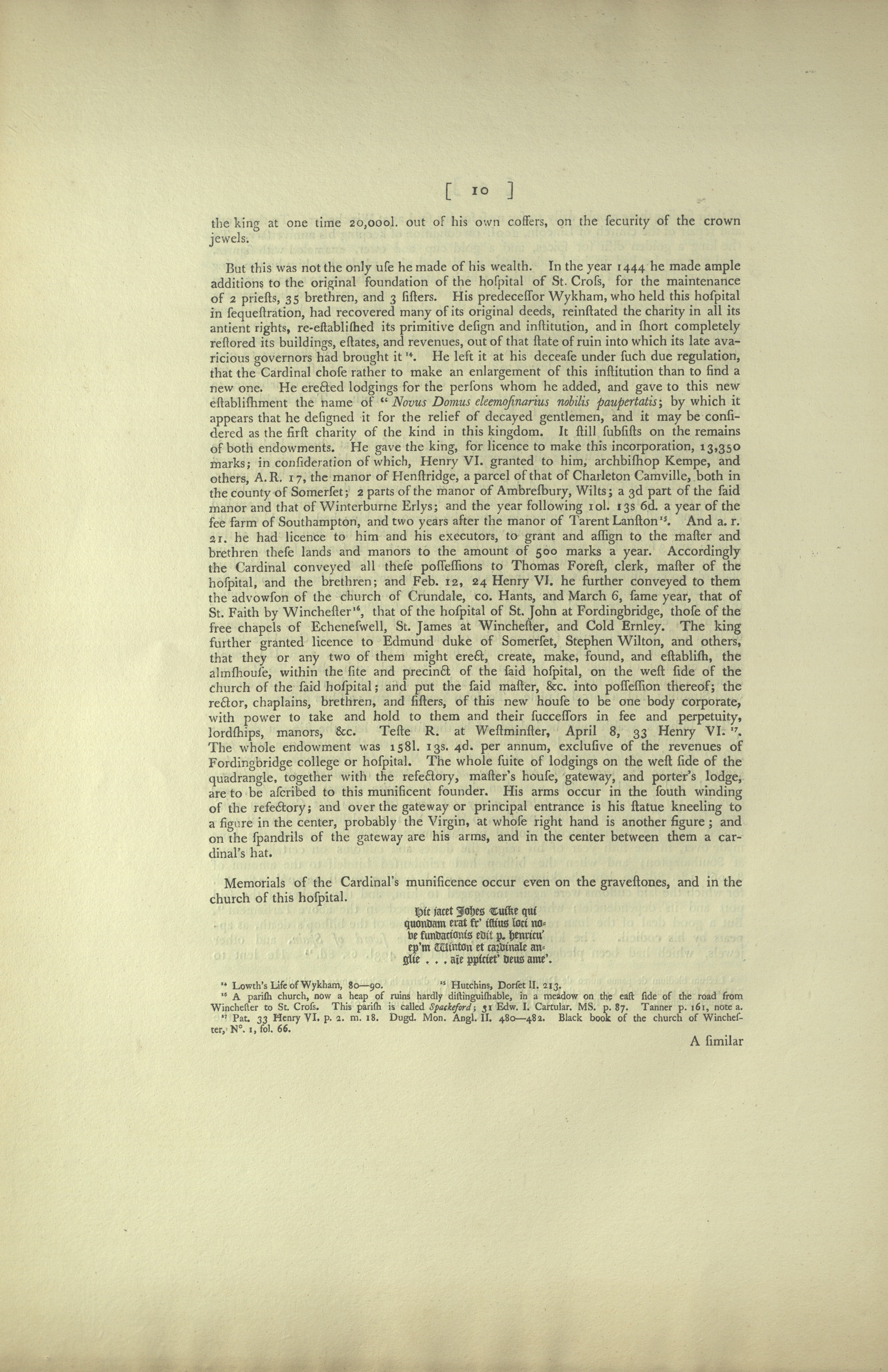
[ (Page) 10 ]
the king at one time 20,000l. out of his own coffers, on the security of the crown jewels.
But this was not the only use he made of his wealth. In the year 1444 he made ample additions to the original foundation of the hospital of St. Cross, for the maintenance of 2 priests, 35 brethren, and 3 sisters.
His predecessor Wykham, who held this hospital in sequestration, had recovered many of its original deeds, reinstated the charity in all its antient rights, re-established its primitive design and institution, and in short completely restored its buildings, estates, and revenues, out of that state of ruin into which its late avaricious governors had brought it14. He left it at his decease under such due regulation, that the Cardinal chose rather to make an enlargement of this institution than to find a new one. He erected lodgings for the persons whom he added, and gave to this new establishment the name of “Novus Domus eleemosinarius nobilis paupertatis[”] [New Almshouse of Noble Poverty]; by which it appears that he designed it for the relief of decayed gentlemen, and it may be considered as the first charity of the kind in this kingdom. It still subsists on the remains of both endowments. He gave the king, for licence to make this incorporation, 13,350 marks; in consideration of which, Henry VI. granted to him, archbishop Kempe, and others, A.R. 17, the manor of Henstridge, a parcel of that of Charleton Camville, both in the county of Somerset; 2 parts of the manor of Ambresbury, Wilts; a 3d part of the said manor and that of Winterburne Erlys; and the year following 10l. 13s. 6d. a year of the fee farm of Southampton, and two years after the manor of Tarent Lanston15. And a.r. 21. he had a licence to him and his executors, to grant and assign to the master and brethren these lands and manors to the amount of 500 marks a year. Accordingly the Cardinal conveyed all these possessions to Thomas Forest, clerk, master of the hospital, and the brethren; and Feb. 12, 24 Henry VI. he further conveyed to them the advowson of the church of Crundale, co. Hants, and March 6, same year, that of St. Faith by Winchester16, that of the hospital of St. John at Fordingbridge, those of the free chapels of Echeneswell, St. James at Winchester, and Cold Ernley. The king further granted licence to Edmund duke of Somerset, Stephen Wilton, and others, that they or any two of them might erect, create, make, found, and establish, the almshouse, within the site and precinct of the said hospital, on the west side of the church of the said hospital; and put the said master, &c. into possession thereof; the rector, chaplains, brethren, and sisters, of this new house to be one body corporate, with power to take and hold to them and their successors in see and perpetuity, lordships, manors, &c. Teste R. at Westminster, April 8, 33 Henry VI.17. The whole endowment was 158l. 13s. 4d. per annum, exclusive of the revenues of Fordingbridge college or hospital. The whole suite of lodgings on the west side of the quadrangle, together with the rectory, master’s house, gateway, and porter’s lodge, are to be ascribed to this munificent founder. His arms occur in the south winding of the refectory; and over the gateway or principal entrance is his statue kneeling to a figure in the center, probably the Virgin, at whose right hand is another figure; and on the spandrils of the gateway are his arms, and in the center between them a cardinal’s hat.
Memorials of the Cardinal’s munificence occur even on the gravestones, and in the church of this hospital.
Hic jacet Johes Tuike qui
quondam erat fr’ istius loci no-
ve fundacionis edit p. henricu’
ep’m Winton et cardinale an-
glie . . . aie ppiciet’ deus ame’.
[Here lies John Tuike, who was formerly brother of this place,
a new construction (lit. “foundation”) sponsored (or “brought forth/about”)
by Henry, bishop of Winchester and cardinal of England,
to whose soul may God be propitious. Amen.]
14 Lowth’s Life of Wykham, 80—90.
15 Hutchins, Dorset II. 213.
16 A parish church, now a heap of ruins hardly distinguishable, in a meadow on the east side of the road from Winchester to St. Cross. This parish is called Spackeford; 31 Edw. I. Cartular. MS. p. 87. Tanner p. 161, note a.
17 Pat. 33 Henry VI. p. 2. m. 18. Dugd. Mon. Angl. II. 480—482. Black book of the church of Winchester, No. 1, fol. 66.
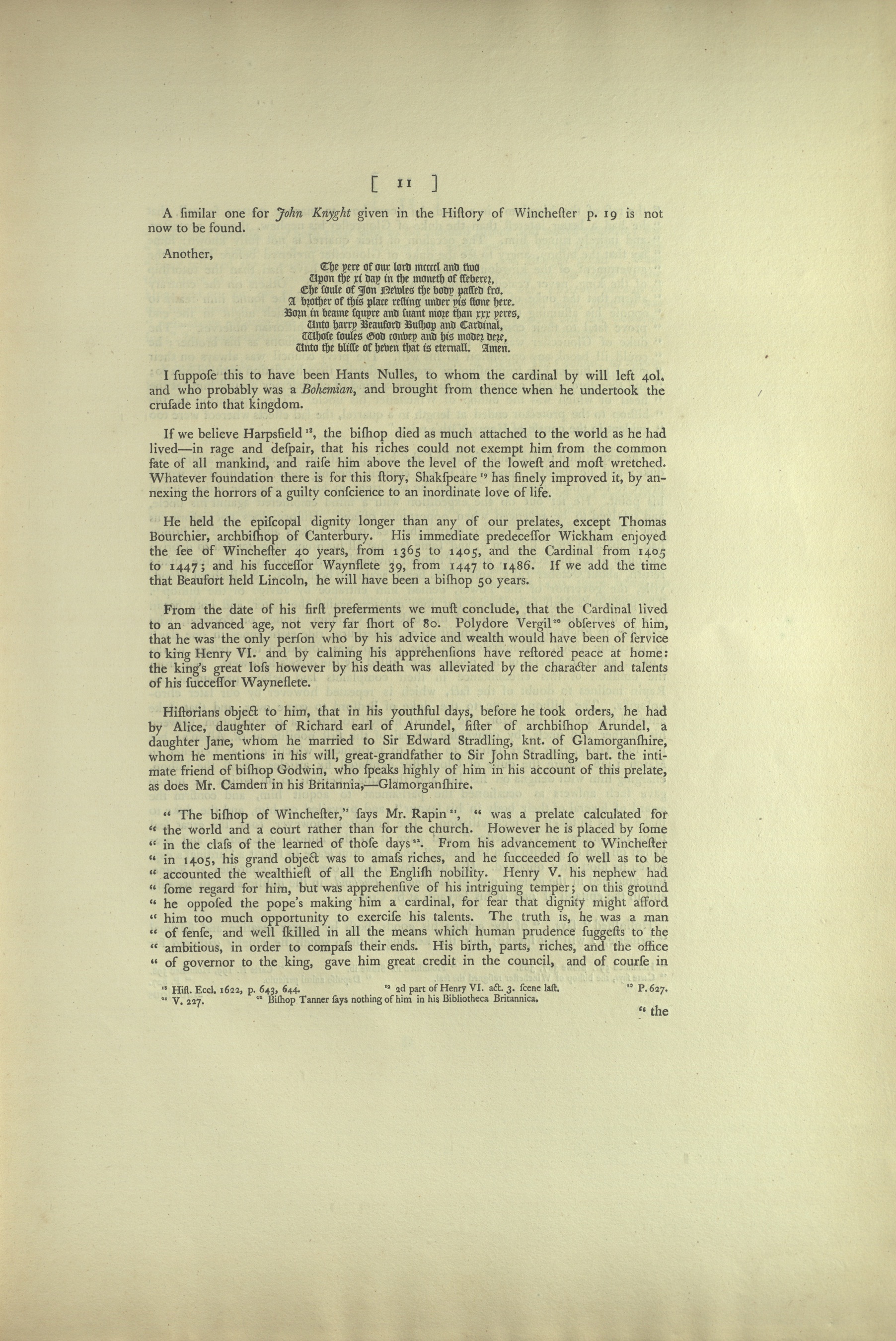
[ (Page) 11 ]
A similar one for John Knyght given in the History of Winchester p. 19 is not now to be found.
Another,
The yere of our lord mccccl and two
Upon the xi day in the moneth of ffeberer,
The soule of Jon Newles the body passed fro.
A brother of this place resting under yis stone here.
Born in beame squyre and suant more than xxx yeres,
Unto harry Beauford Bushop and Cardinal,
Whose soules God convey and his moder dere,
Unto the blisse of heven that is eternall. Amen.
I suppose this to have been Hants Nulles, to whom the cardinal by will left 40l. and who probably was a Bohemian, and brought from thence when he undertook the crusade into that kingdom.
If we believe Harpsfield18, the bishop died as much attached to the world as he had lived—in rage and despair, that his riches could not exempt him from the common fate of all mankind, and raise him above the level of the lowest and most wretched. Whatever foundation there is for this story, Shakspeare19 has finely improved it, by annexing the horrors of a guilty conscience to an inordinate love of life.
He held the episcopal dignity longer than any of our prelates, except Thomas Bourchier, archbishop of Canterbury. His immediate predecessor Wickham enjoyed the see of Winchester 40 years, from 1365 to 1405, and the Cardinal from 1405 to 1447; and his successor Waynflete 39, from 1447 to 1486. If we add the time that Beaufort held Lincoln, he will have been a bishop 50 years.
From the date of his first preferments we must conclude, that the Cardinal lived to an advanced age, not very far short of 80. Polydore Vergil20 observes of him, that he was the only person who by his advice and wealth would have been of service to king Henry VI. and by calming his apprehensions have restored peace at home: the king’s great loss however by his death was alleviated by the character and talents of his successor Wayneflete.
Historians object to him, that in his youthful days, before he took orders, he had by Alice, daughter of Richard earl of Arundel, sister of archbishop Arundel, a daughter Jane, whom he married to Sir Edward Stradling, knt. of Glamorganshire, whom he mentions in his will, great-grandfather to Sir John Stradling, bart. the intimate friend of bishop Godwin, who speaks highly of him in his account of this prelate, as does Mr. Camden in his Britannia,—Glamorganshire.
“The bishop of Winchester,” says Mr. Rapin21, “was a prelate calculated for the world and a court rather than for the church. However he is placed by some in the class of the learned of those days22. From his advancement to Winchester in 1405, his grand object was to amass riches, and he succeeded so well as to be accounted the wealthiest of all the English nobility. Henry V. his nephew had some regard for him, but was apprehensive of his intriguing temper; on this ground he opposed the pope’s making him a cardinal, for fear that dignity might afford him too much opportunity to exercise his talents. The truth is, he was a man of sense, and well skilled in all the means which human prudence suggests to the ambitious, in order to compass their ends. His birth, parts, riches, and the office of governor to the king, gave him great credit in the council and of course in
18 Hist. Eccl. 1622, p. 643, 644.
19 2d part of Henry VI. act. 3. scene last.
20 P. 627.
21 V. 227.
22 Bishop Tanner says nothing of him in his Bibliotheca Britannica.
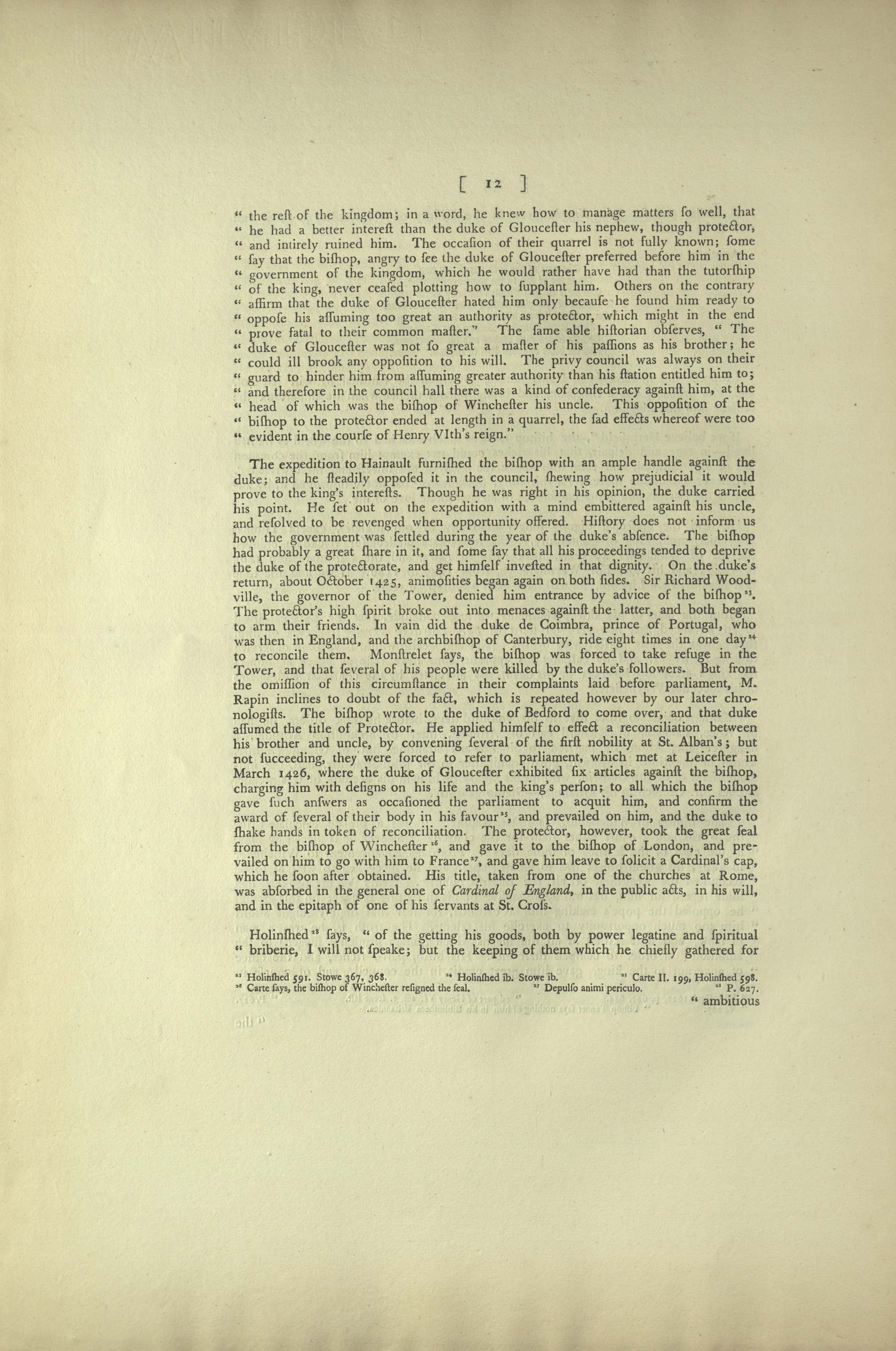
[ (Page) 12 ]
“the rest of his kingdom; in a word, he knew how to manage matters so well, that he had a better interest than the duke of Gloucester his nephew, though protector, and intirely ruined him.
Read more/less…"The occasion of their quarrel is not fully known; some say that the bishop, angry to see the duke of Gloucester preferred before him in the government of the kingdom, which he would rather have had than the tutorship of the king, never ceased plotting how to supplant him. Others on the contrary affirm that the duke of Gloucester hated him only because he found him ready to oppose his assuming too great an authority as protector, which might in the end prove fatal to their common master.” The same able historian observes, “The duke of Gloucester was not so great a master of his passions as his brother; he could ill brook any opposition to his will. The privy council was always on their guard to hinder him from assuming greater authority than his station entitled him to; and therefore in the council hall there was a kind of confederacy against him, at the head of which was the bishop of Winchester his uncle. This opposition of the bishop to the protector ended at length in a quarrel, the sad effects whereof were too evident in the course of Henry VIth’s reign.”
The expedition to Hainault furnished the bishop with an ample handle against the duke; and he steadily opposed it in the council, shewing how prejudicial it would prove to the king’s interests. Though he was right in his opinion, the duke carried his point. He set out on the expedition with a mind embittered against his uncle, and resolved to be revenged when opportunity offered. History does not inform us how the government was settled during the year of the duke’s absence. The bishop had probably a great share in it, and some say that all his proceedings tended to deprive the duke of the protectorate, and get himself invested in that dignity. On the duke’s return, about October 1425, animosities began again on both sides. Sir Richard Woodville, the governor of the Tower, denied him entrance by advice of the bishop23. The protector’s high spirit broke out into menaces against the latter, and both began to arm their friends. In vain did the duke de Coimbra, prince of Portugal, who was then in England, and the archbishop of Canterbury, ride eight times in one day24 to reconcile them. Monstrelet says, the bishop was forced to take refuge in the Tower, and that several of his people were killed by the duke’s followers. But from the omission of this circumstance in their complaints laid before parliament, M. Rapin inclines to doubt of the fact, which is repeated however by our later chronologists. The bishop wrote to the duke of Bedford to come over, and that duke assumed the title of Protector. He applied himself to effect a reconciliation between his brother and uncle, by convening several of the first nobility at St. Alban’s; but not succeeding, they were forced to refer to parliament, which met at Leicester in March 1426, where the duke of Gloucester exhibited six articles against the bishop, charging him with designs on his life and the king’s person; to all which the bishop gave such answers as occasioned the parliament to acquit him, and confirm the award of several of their body in his favour25, and prevailed on him, and the duke to shake hands in token of reconciliation. The protector, however, took the great seal from the bishop of Winchester26, and gave it to the bishop of London, and prevailed on him to go with him to France27, and give him leave to solicit a Cardinal’s cap, which he soon after obtained. His title, taken from one of the churches at Rome, was absorbed in the general one of Cardinal of England, in the public acts, in his will, and in the epitaph of one of his servants at St. Cross.
Holinshed28 says, “of the getting his goods, both by power legatine and spiritual briberie, I will not speake; but the keeping of them which he chiefly gathered for
23 Holinshed 591. Stowe 367, 368.
24 Holinshed ib. Stowe ib.
25 Carte II. 199, Holinshed 598.
26 Carte says, the bishop of Winchester resigned the seal.
27 Depulso animi periculo. [The danger to his soul is cast aside.]
28 P. 627.

[ (Page) 13 ]
“ambitious purpose, was both great losse to his naturall prince and native countrie; for his hidden riches might have well helpen the king, and his secret treasure might have relieved the commonaltie, when monie was scant, and charges great.”
Read more/less…
What truth there is in this character, will best be judged by reflecting on his loans to the king, and on the use of his Bohemian levies in the French war, whatever became of the imputation on his learning and affability. But when Holinshed adds, that he was “rich above measure but not very liberal;—manie things beginning but few performing;” his augmentation of St. Cross’ hospital will suffice to refute this charge.
It is true, Godwin insinuates that the apprehension of Henry Vth’s design, to appropriate the enormous wealth of the church to his French war, which had involved him in an immense debt, induced the cardinal to lend him 20,000l. out of his own coffers.
“His high dignity, great parts, learning, wisdom, and experience in affairs, probably gave him more weight than the duke of Gloucester had in the council which ordered the affairs of the kingdom29.”
Mr. Hume30 describes Henry Beaufort as a prelate of great capacity and experience, but of an intriguing and dangerous character. In the Parliamentary History (II. 78, 83,128, 129, 144, 148, 151, 155, 292, 200) are nine of his speeches as Chancellor, at the opening of parliaments, taken, according to the fashion of the age, from texts of scripture, occasionally intermixt with Latin quotations of the same kind, and containing sundry scholastic divisions. Two more speeches are there mentioned, one declaring the cause of summons at the meeting of the parliament 1410, there being no chancellor; the other 1415, when the parliament met after a few weeks adjournment. (Ib. No III. 1524.) He was chancellor 1413 to 1416. R.G. [Richard Gough]
29 Carte II, 698.
30 Hist. of Engl. III. 141, 80.
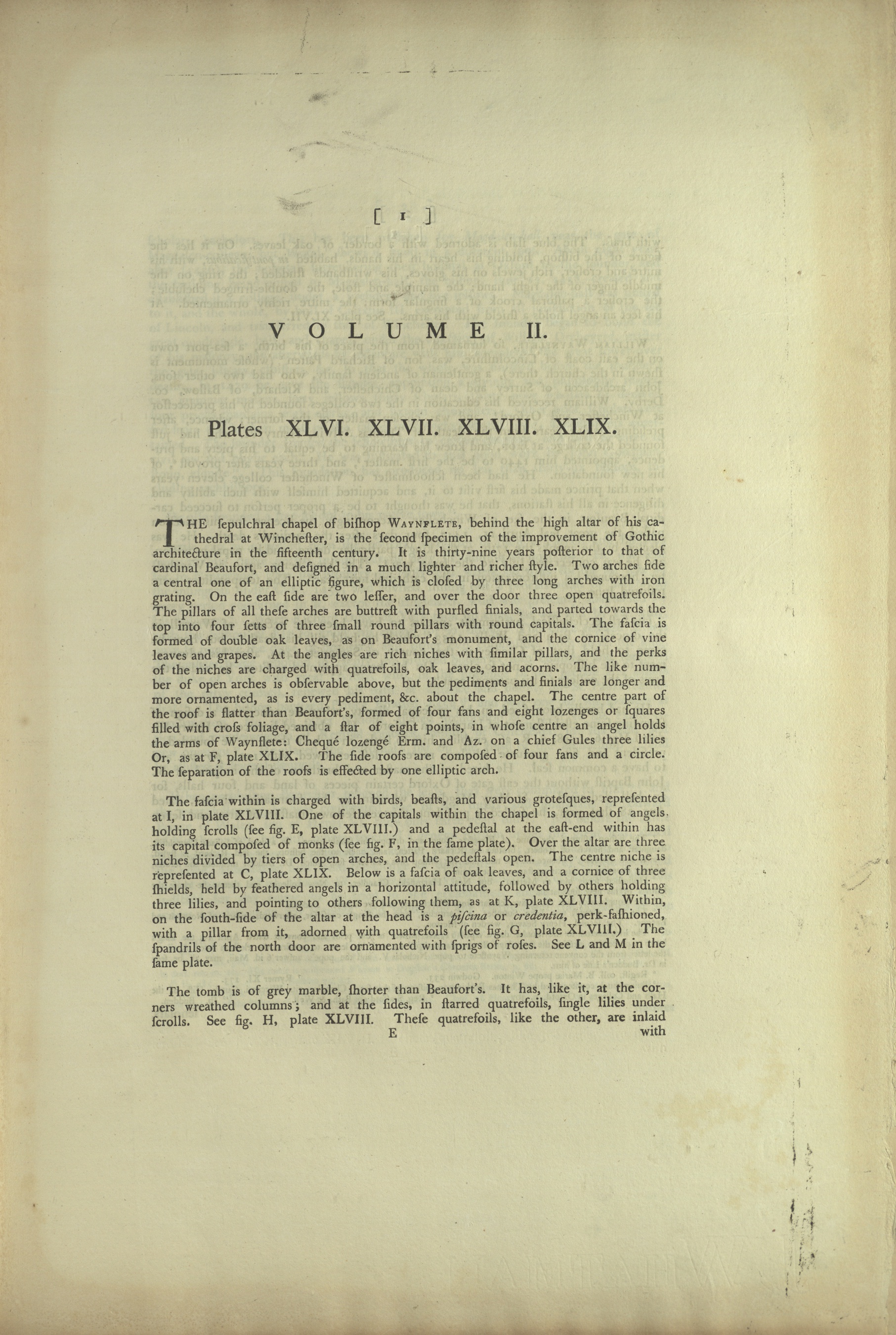
[ (Page) 1 ]
VOLUME II. Plates XLVI. XLVII. XLVIII. XLIX.
THE sepulchral chapel of bishop WAYNFLETE, behind the high altar of his cathedral at Winchester, is the second specimen of the improvement of Gothic architecture in the fifteenth century.
Read more/less…
It is thirty-nine years posterior to that of cardinal Beaufort, and designed in a much lighter and richer style. Two arches side a central one of an elliptic figure, which is closed by three long arches with iron grating. On the east side are two lesser, and over the door three open quatrefoils. The pillars of all these arches are buttrest with purfled finials, and parted towards the top into four setts of three small round pillars with round capitals. The fascia is formed of double oak leaves, as on Beaufort’s monument, and the cornice of vine leaves and grapes. At the angles are rich niches with similar pillars, and the perks of the niches are charged with quatrefoils, oak leaves, and acorns. The like number of open arches is observable above, but the pediments and finials are longer and more ornamented, as is every pediment, &c. about the chapel. The centre part of the roof is flatter than Beaufort’s, formed of four fans and eight lozenges or squares filled with cross foliage, and a star of eight points, in whose centre an angel holds the arms of Waynflete: Chequé lozengé Erm. and Az. on a chief Gules three lilies Or, as at F, plate XLIX. The side roofs are composed of four fans and a circle. The separation of the roofs is effected by one elliptic arch.
The fascia within is charged with birds, beasts, and various grotesques, represented at I, in plate XLVIII. One of the capitals within the chapel is formed of angels holding scrolls (see fig. E, plate XLVIII.) and a pedestal at the east-end within has its capital composed of monks (see fig. F, in the same plate). Over the altar are three niches divided by tiers of open arches, and the pedestals open. The centre niche is represented at C, plate XLIX. Below is a fascia of oak leaves, and a cornice of three shields, held by feathered angels in a horizontal attitude, followed by others holding three lilies, and pointing to others following them, as at K, plate XLVIII. Within, on the south-side of the alter at the head is a piscina or credentia, perk-fashioned, with a pillar from it, adorned with quatrefoils (see fig. G, plate XLVIII.) The spandrils of the north door are ornamented with sprigs of roses. See L and M in the same plate.
The tomb is of grey marble, shorter than Beaufort’s. It has, like it, at the corners wreathed columns; and at the sides, in starred quatrefoils, single lilies under scrolls. See fig. H, plate XLVIII. These quatrefoils, like the other, are inlaid
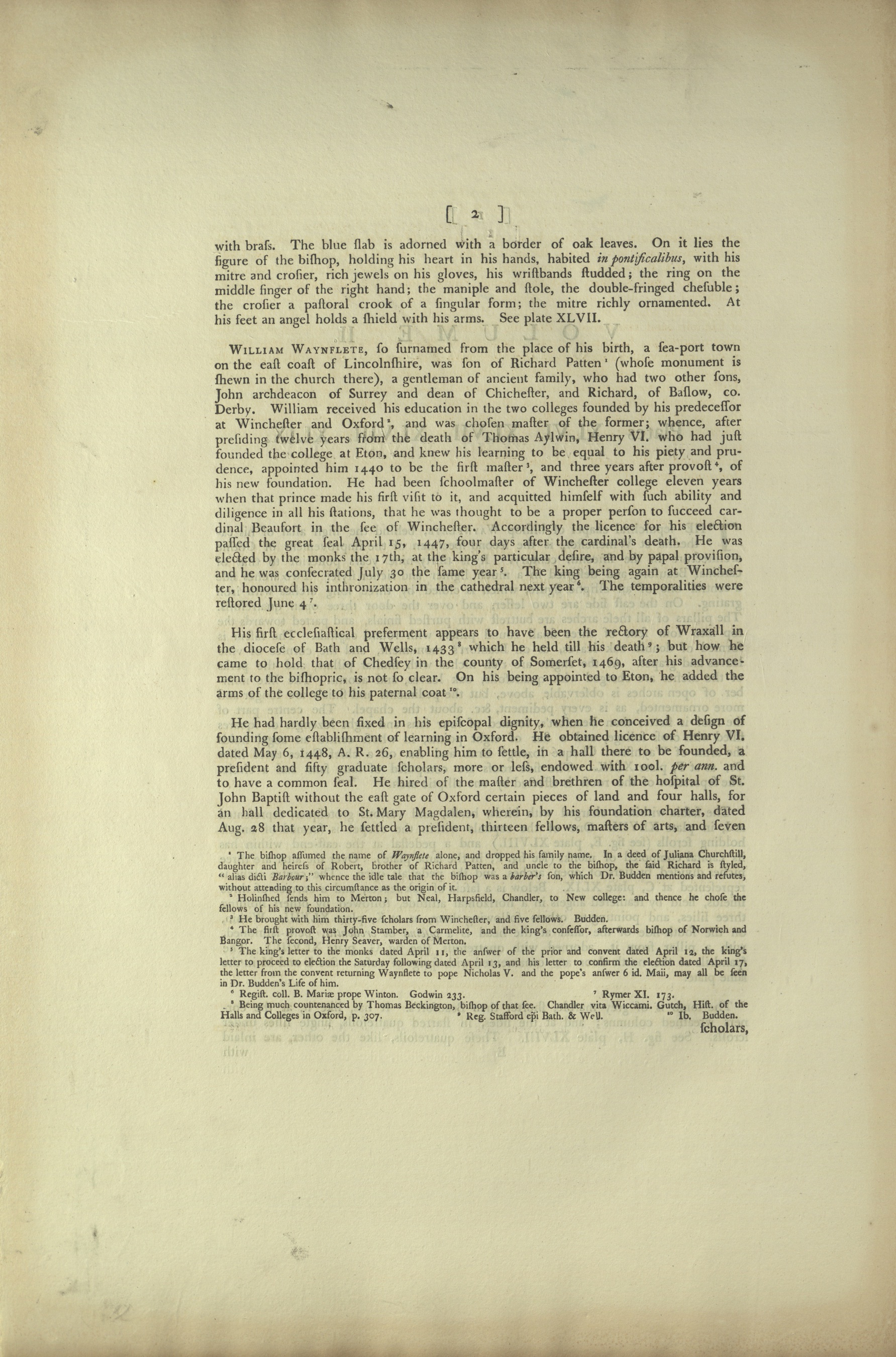
[ (Page) 2 ]
with brass. The blue slab is adorned with a border of oak leaves. On it lies the figure of the bishop, holding his heart in his hands, habited in pontificalibus, with his mitre and crosier, rich jewels on his gloves, his wristbands studded; the ring on the middle finger of the right hand; the maniple and stole, the double-fringed chesuble; the crosier a pastoral crook of a singular form; the mitre richly ornamented. At his feet an angel holds a shield with his arms. See plate XLVII.
Read more/less…
WILLIAM WAYNFLETE, so surnamed from the place of his birth, a sea-port town on the east coast of Lincolnshire, was son of Richard Patten1 (whose monument is shewn in the church there), a gentleman of ancient family, who had two other sons, John archdeacon of Surrey and dean of Chichester, and Richard, of Baslow, co. Derby. William received his education in the two colleges founded by his predecessor at Winchester and Oxford2, and was chosen master of the former; whence, after presiding twelve years from the death of Thomas Aylwin, Henry VI. who had just founded the college at Eton, and knew his learning to be equal to his piety and prudence, appointed him 1440 to be the first master3, and three years after provost4, of his new foundation. He had been schoolmaster of Winchester college eleven years when that prince made his first visit to it, and acquitted himself with such ability and diligence in all his stations, that he was thought to be a proper person to succeed cardinal Beaufort in the see of Winchester. Accordingly the licence for his election passed the great seal April 15, 1447, four days after the cardinal’s death. He was elected by the monks the 17th, at the king’s particular desire, and by papal provision, and he was consecrated July 30 the same year5. The king being again at Winchester, honoured his inthronization in the cathedral next year6. The temporalities were restored June 47.
His first ecclesiastical preferment appears to have been at the rectory of Wraxall in the diocese of Bath and Wells, 14338 which he held till his death9; but how he came to hold that of Chedsey in the county of Somerset, 1469, after his advancement to the bishopric, is not so clear. On his being appointed to Eton, he added the arms of the college to his paternal coat10.
He had hardly been fixed in his episcopal dignity, when he conceived a design of founding some establishment of learning in Oxford. He obtained licence of Henry VI. dated May 6, 1448, A.R. 26, enabling him to settle, in a hall there to be founded, a president and fifty graduate scholars, more or less, endowed with 100l. per ann. and to have a common seal. He hired of the master and brethren of the hospital of St. John Baptist without the east gate of Oxford certain pieces of land and four halls, for an hall dedicated to St. Mary Magdalen, wherein, by his foundation charter, dated Aug. 28 that year, he settled a president, thirteen fellows, masters of arts, and seven
1 The bishop assumed the name of Waynflete alone, and dropped his family name. In a deed of Juliana Churchstill, daughter and heiress of Robert, brother of Richard Patten, and uncle to the bishop, the said Richard is styled, “alias dicti Barbour;” [otherwise known as] whence the idle tale that the bishop was a barber’s son, which Dr. Budden mentions and refutes, without attending to this circumstance as the origin of it.
2 Holinshed sends him to Merton; but Neal, Harpsfield, Chandler, to New college: and thence he chose the fellows of his new foundation.
3 He brought with him thirty-five scholars from Winchester, and five fellows. Budden.
4 The first provost was John Stamber, a Carmelite, and the king’s confessor, afterwards bishop of Norwich and Bangor. The second, Henry Seaver, warden of Merton.
5 The king’s letter to the monks dated April 11, the answer of the prior and convent dated April 12, the king’s letter to proceed to election the Saturday following dated April 13, and his letter to confirm the election dated April 17, the letter from the convent returning Waynflete to pope Nicholas V. and the pope’s answer 6 id. Maii, may all be seen in Dr. Budden’s Life of him.
6 Regist. coll. B. Mariae prope Winton. Godwin 233.
7 Rymer XI. 173.
8 Being much countenanced by Thomas Beckington, bishop of that see. Chandler vita Wiccami. Gutch, Hist. of the Halls and Colleges in Oxford, p. 307.
9 Reg. Stafford ep̃i Bath. & Well.
10 Ib. Budden.
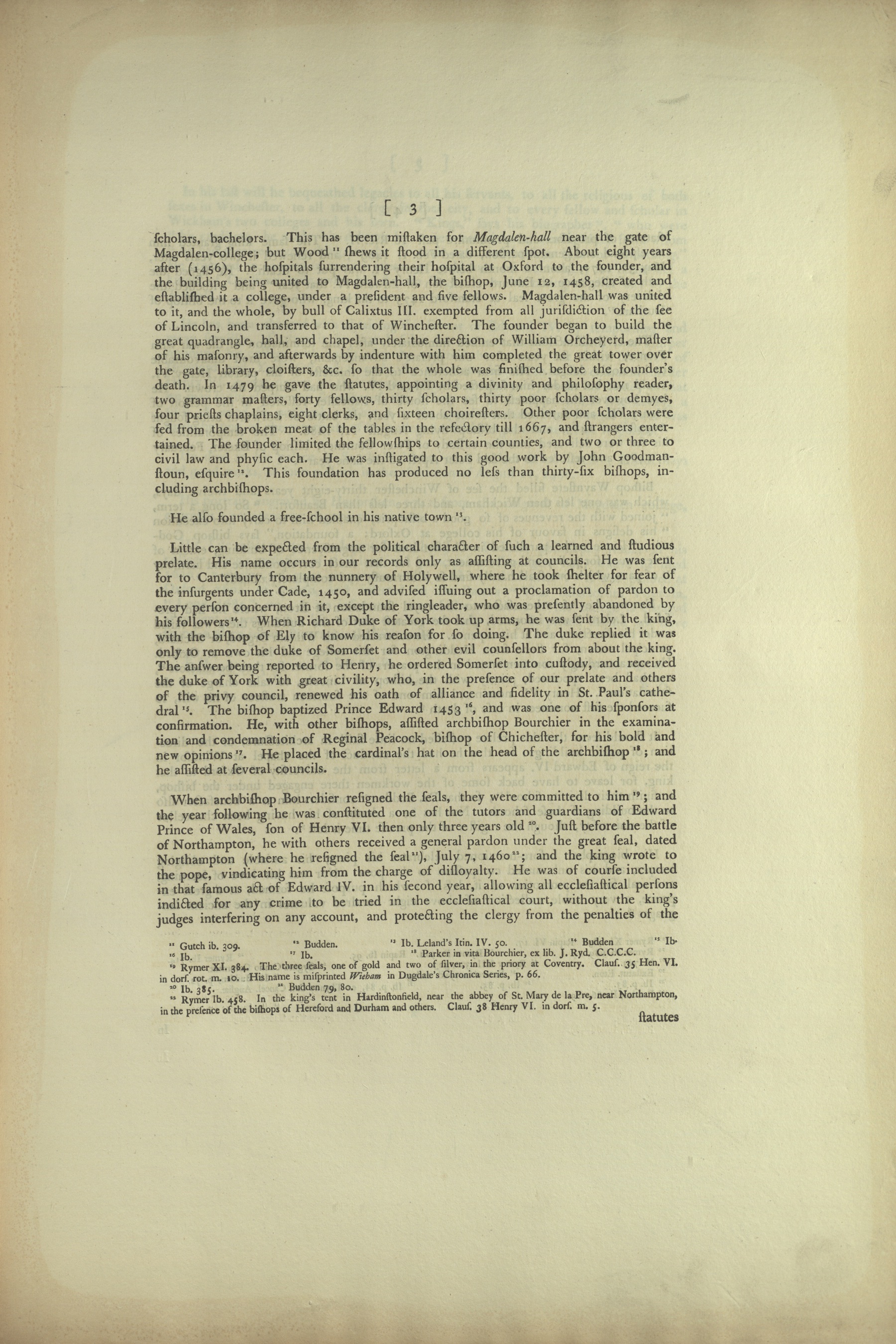
[ (Page) 3 ]
scholars, bachelors. This has been mistaken for Magdalen-hall near the gate of Magdalen-college; but Wood11 shews it stood in a different spot. About eight years after (1456), the hospitals surrendering their hospital at Oxford to the founder, and the building being united to Magdalen-hall, the bishop, June 12, 1458, created and established it a college, under a president and five fellows.
Read more/less…
Magdalen-hall was united to it, and the whole, by bull of Calixtus III. exempted from all jurisdiction of the see of Lincoln, and transferred to that of Winchester. The founder began to build the great quadrangle, hall, and chapel, under the direction of William Orcheyerd, master of his masonry, and afterwards by indenture with him completed the great tower over the gate, library, cloisters, &c. so that the whole was finished before the founder’s death. In 1479 he gave the statutes, appointing a divinity and philosophy reader, two grammar masters, forty fellows, thirty scholars, thirty poor scholars or demyes, four priests chaplains, eight clerks, and sixteen choiresters. Other poor scholars were fed from the broken meat of the tables in the refectory till 1667, and strangers entertained. The founder limited the fellowships to certain counties, and two or three to civil law and physic each. He was instigated to this good work by John Goodmanstoun, esquire12. This foundation has produced no less than thirty-six bishops, including archbishops.
He also founded a free-school in his native town13.
Little can be expected from the political character of such a learned and studious prelate. His name occurs in our records only as assisting at councils. He was sent for to Canterbury from the nunnery of Holywell, where he took shelter for fear of the insurgents under Cade, 1450, and advised issuing out a proclamation of pardon to every person concerned in it, except the ringleader, who was presently abandoned by his followers14. When Richard Duke of York took up arms, he was sent by the king, with the bishop of Ely to know his reason for so doing. The duke replied it was only to remove the duke of Somerset and other evil counsellors from about the king. The answer being reported to Henry, he ordered Somerset into custody, and received the duke of York with great civility, who, in the presence of our prelate and others of the privy council, renewed his oath of alliance and fidelity in St. Paul’s cathedral15. The bishop baptized Prince Edward 145316, and was one of his sponsors at confirmation. He, with other bishops, assisted archbishop Bourchier in the examination and condemnation of Reginal Peacock, bishop of Chichester, for his bold and new opinions17. He placed the cardinal’s hat on the head of the archbishop18; and he assisted at several councils.
When archbishop Bourchier resigned the seals, they were committed to him19; and the year following he was constituted one of the tutors and guardians of Edward Prince of Wales, son of Henry VI. then only three years old20. Just before the battle of Northampton, he with others received a general pardon under the great seal, dated Northampton (where he resigned the seal21), July 7, 146022; and the king wrote to the pope, vindicating him from the charge of disloyalty. He was of course included in that famous act of Edward IV. in his second year, allowing all ecclesiastical persons indicted for any crime to be tried in the ecclesiastical court, without the king’s judges interfering on any account, and protecting the clergy from the penalties of the
11 Gutch ib. 309.
12 Budden.
13 Ib. Leland’s Itin. IV. 50.
14 Budden
15 Ib.
16 Ib.
17 Ib.
18 Parker in vita Bourchier, ex lib. J. Ryd. C.C.C.C.
19 Rymer XI. 384. The three seals, one of gold and two of silver, in the priory at Coventry. Claus. 35 Hen. VI. in dors. rot. m. 10. His name is misprinted Wieham in Dugdale’s Chronica Series, p. 66.
20 Ib. 385.
21 Budden 79, 80.
22 Rymer Ib. 458. In the king’s tent in Hardinstonfield, near the abbey of St. Mary de la Pre, near Northampton, in the presence of the bishops of Hereford and Durham and others. Claus. 38 Henry VI. in dors. m. 5.
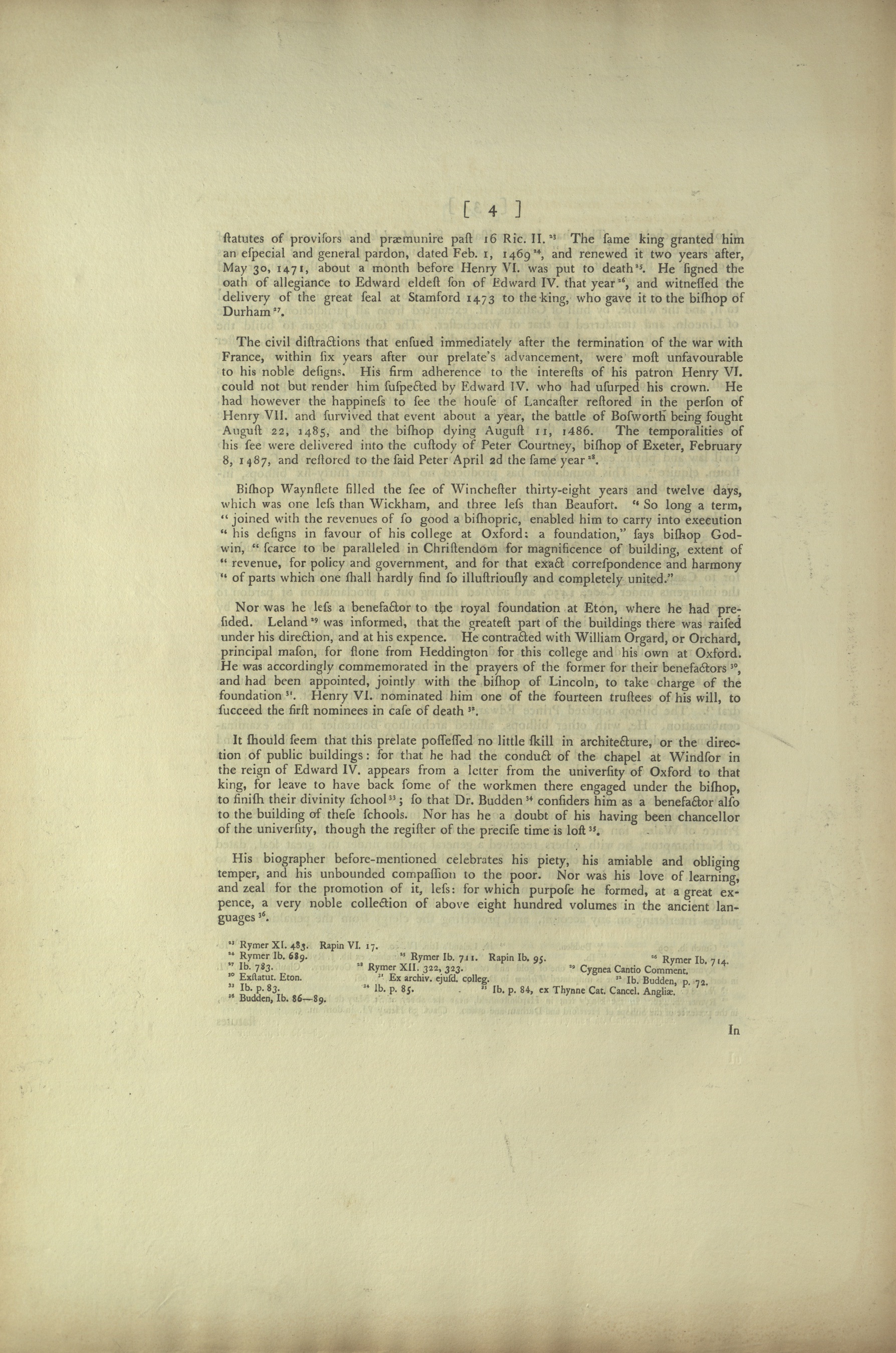
[ (Page) 4 ]
statutes of provisors and praemunire past 16 Ric. II.23 The same king granted him an especial and general pardon, dated Feb. 1, 146924, and renewed it two years after, May 30, 1471, about a month before Henry VI. was put to death25. He signed the oath of allegiance to Edward eldest son of Edward IV. that year26, and witnessed the delivery of the great seal at Stamford 1473 to the king, who gave it to the bishop of Durham27.
Read more/less…
The civil distractions that ensued immediately after the termination of the war with France, within six years after our prelate’s advancement, were most unfavourable to his noble designs. His firm adherence to the interests of his patron Henry VI. could not but render him suspected by Edward IV. who had usurped his crown. He had however the happiness to see the house of Lancaster restored in the person of Henry VII. and survived that event about a year, the battle of Bosworth being fought August 22, 1485, and the bishop dying August 11, 1486. The temporalities of his see were delivered into the custody of Peter Courtney, bishop of Exeter, February 8, 1487, and restored to the said Peter April 2d the same year28.
Bishop Waynflete filled the see of Winchester thirty-eight years and twelve days, which was one less than Wickham, and three less than Beaufort. “So long a term, joined with the revenues of so good a bishopric, enabled him to carry into execution his designs in favour of his college at Oxford: a foundation,” says bishop Godwin, “scarce to be paralleled in Christendom for magnificence of building, extent of revenue, for policy and government, and for that exact correspondence and harmony of parts which one shall hardly find so illustriously and completely united.”
Nor was he less a benefactor to the royal foundation at Eton, where he had presided. Leland29 was informed, that the greatest part of the buildings there was raised under his direction, and at his expence. He contracted with William Orgard, or Orchard, principal mason, for stone from Heddington for this college and his own at Oxford. He was accordingly commemorated in the prayers of the former for their benefactors30, and had been appointed, jointly with the bishop of Lincoln, to take charge of the foundation31. Henry VI. nominated him one of the fourteen trustees of his will, to succeed the first nominees in case of death32.
It should seem that this prelate possessed no little skill in architecture, or the direction of public buildings: for that he had the conduct of the chapel at Windsor in the reign of Edward IV. appears from a letter from the university of Oxford to that king, for leave to have back some of the workmen there engaged under the bishop, to finish their divinity school33; so that Dr. Budden34 considers him as a benefactor also to the building of these schools. Nor has he a doubt of his having been chancellor of the university, though the register of the precise time is lost35.
His biographer before-mentioned celebrates his piety, his amiable and obliging temper, and his unbounded compassion to the poor. Nor was his love of learning, and zeal for the promotion of it, less: for which purpose he formed, at a great expence, a very noble collection of above eight hundred volumes in the ancient languages36.
23 Rymer XI. 483. Rapin VI. 17.
24 Rymer Ib. 689.
25 Rymer Ib. 711. Rapin Ib. 95.
26 Rymer Ib. 714.
27 Ib. 783.
28 Rymer XII. 322, 323.
29 Cygnea Cantio Comment.
30 Exstatut. Eton.
31 Ex archiv. ejusd. colleg.
32 Ib. Budden, p. 72.
33 Ib. p. 83.
34 Ib. p. 85.
35 Ib. p. 84, ex Thynne Cat. Cancel. Angliae.
36 Budden, Ib. 86—89.
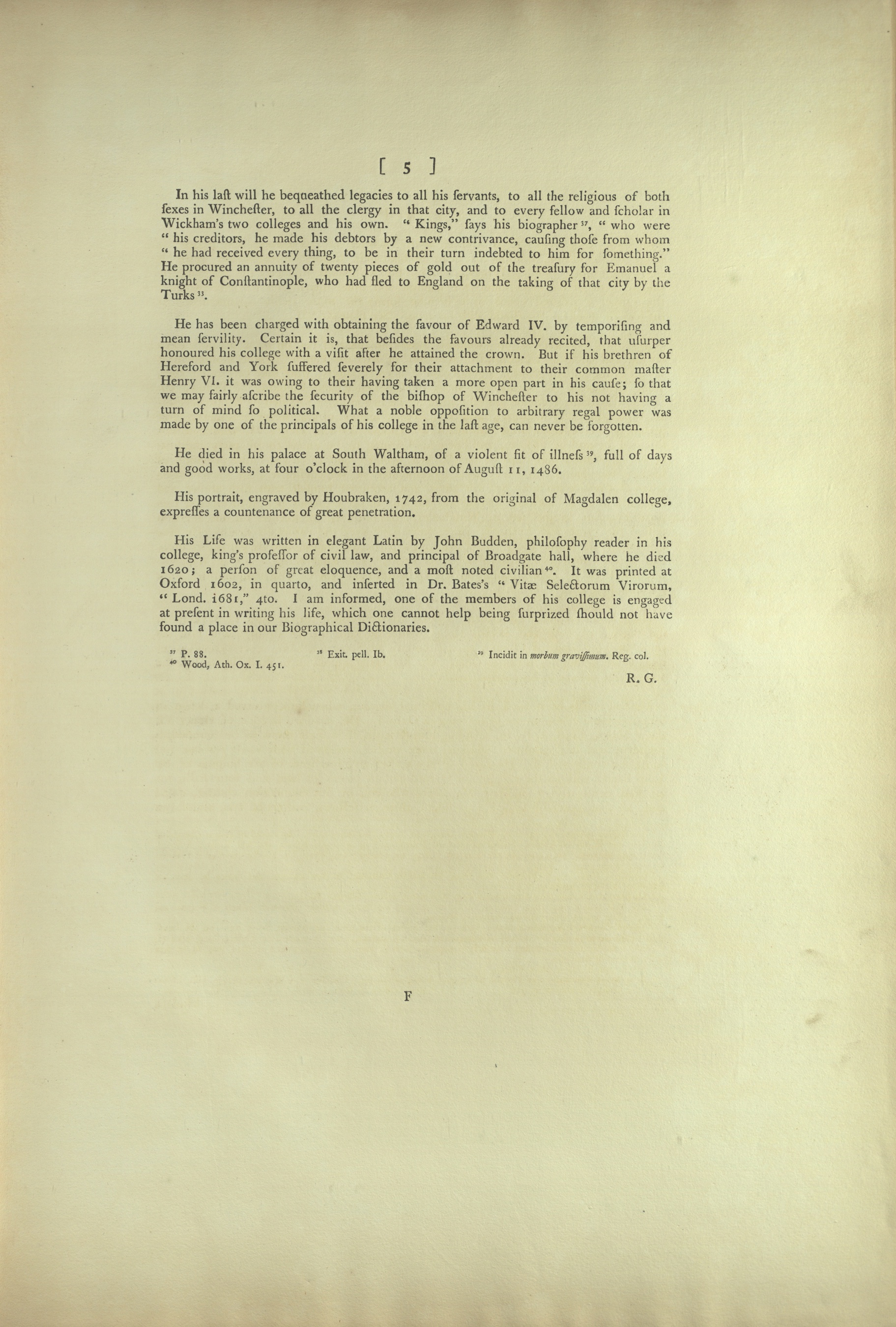
[ (Page) 5 ]
In his last will he bequeathed legacies to all his servants, to all the religious of both sexes in Winchester, to all the clergy in that city, and to every fellow and scholar in Wickham’s two colleges and his own. “Kings,” says his biographer37, “who were his creditors, he made his debtors by a new contrivance, causing those from whom he had received every thing, to be in their turn indebted to him for something.”
Read more/less…
He procured an annuity of twenty pieces of gold out of the treasury for Emanuel a knight of Constantinople, who had fled to England on the taking of that city by the Turks38.
He has been charged with obtaining the favour of Edward IV. by temporising and mean servility. Certain it is, that besides the favours already recited, that usurper honoured his college with a visit after he attained the crown. But if his brethren of Hereford and York suffered severely for their attachment to their common master Henry VI. it was owing to their having taken a more open part in his cause; so that we may fairly ascribe the security of the bishop of Winchester to his not having a turn of mind so political. What a noble opposition to arbitrary regal power was made by one of the principals of his college in the last age, can never be forgotten.
He died in his palace at South Waltham, of a violent fit of illness39, full of days and good works, at four o’clock in the afternoon of August 11, 1486.
His portrait, engraved by Houbraken, 1742, from the original of Magdalen college, expresses a countenance of great penetration.
His Life was written in elegant Latin by John Budden, philosophy reader in his college, king’s professor of civil law, and principal of Broadgate hall, where he died 1620; a person of great eloquence, and a most noted civilian40. It was printed at Oxford 1602, in quarto, and inserted in Dr. Bates’s “Vitae Selectorum Virorum [Lives of Select Men], Lond. 1681,” 4to. I am informed, one of the members of his college is engaged at present in writing his life, which one cannot help being surprized should not have found a place in our Biographical Dictionaries.
37 P. 88.
38 Exit. pell. Ib.
39 Incidit in morbum gravissimum [He was struck by a most serious disease]. Reg. col.
40 Wood, Ath. Ox. I. 451.
R.G. [Richard Gough]
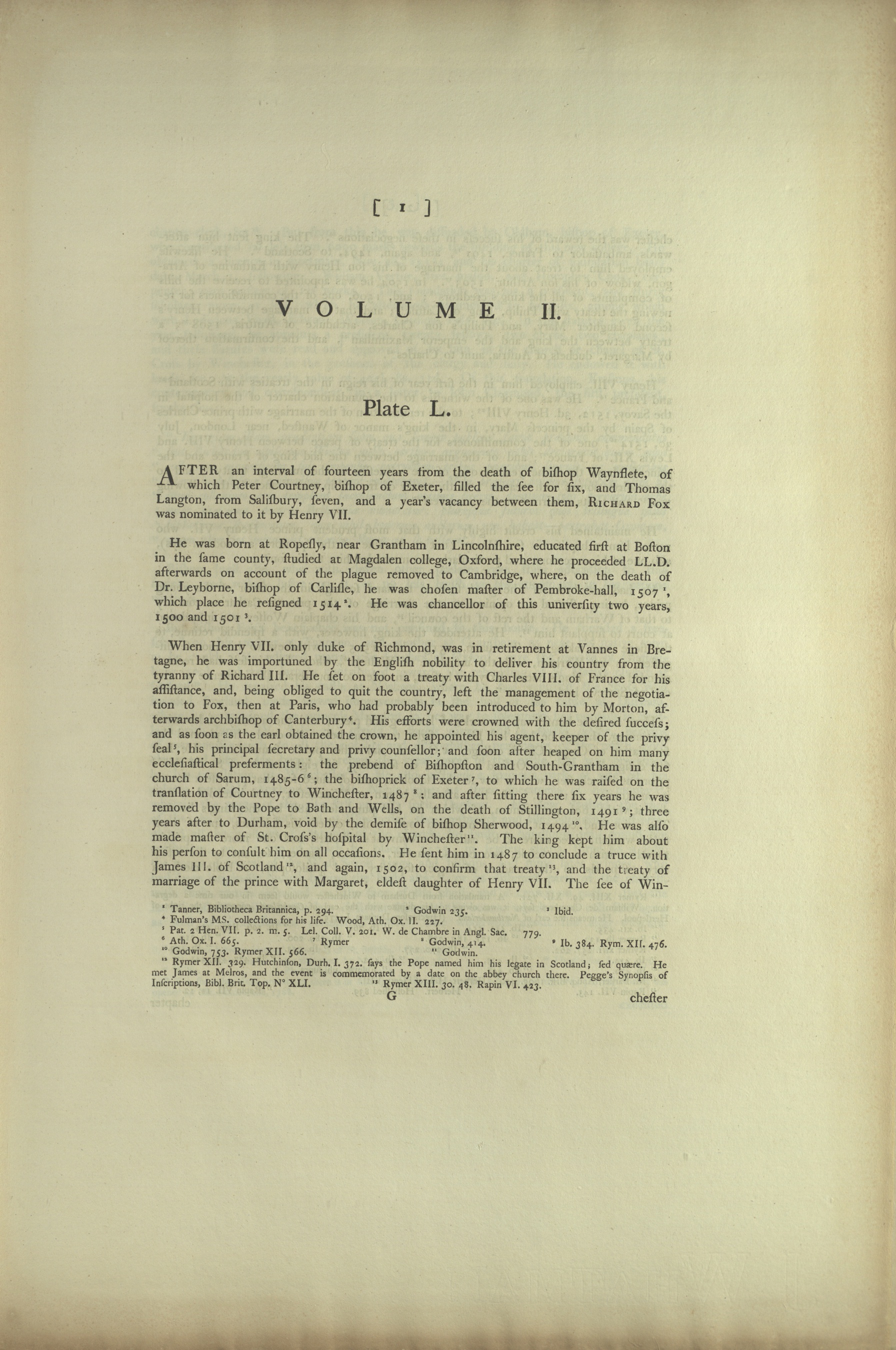
[ (Page) 1 ]
VOLUME II. Plate L.
AFTER an interval of fourteen years from the death of bishop Waynflete, of which Peter Courtney, bishop of Exeter, filled the see for six, and Thomas Langton, from Salisbury, seven, and a year’s vacancy between them, RICHARD FOX was nominated to it by Henry VII.
Read more/less…
He was born at Ropesly, near Grantham in Lincolnshire, educated first at Boston in the same county, studied at Magdalen college, Oxford, where he proceeded LL.D. afterwards on account of the plague removed to Cambridge, where, on the death of Dr. Leyborne, bishop of Carlisle, he was chosen master of Pembroke-hall, 15071, which place he resigned 15142. He was chancellor of this university two years, 1500 and 15013.
When Henry VII. only duke of Richmond, was in retirement at Vannes in Bretagne, he was importuned by the English nobility to deliver his country from the tyranny of Richard III. He set on foot a treaty with Charles VIII. of France for his assistance, and, being obliged to quit the country, left the management of the negotiation to Fox, then at Paris, who had probably been introduced to him by Morton, afterwards archbishop of Canterbury4. His efforts were crowned with the desired success; and as soon as the earl obtained the crown, he appointed his agent, keeper of the privy seal5, his principal secretary and privy counsellor; and soon after heaped him many ecclesiastical preferments: the prebend of Bishopston and South-Grantham in the church of Sarum 1485-66; the bishoprick of Exeter7, to which he was raised on the translation of Courtney to Winchester, 14878; and after sitting there six years he was removed by the Pope to Bath and Wells, on the death of Stillington, 14919; three years after to Durham, void by the demise of bishop Sherwood, 149410. He was also made master of St. Cross’s hospital by Winchester11. The king kept him about his person to consult him on all occasions. He sent him in 1487 to conclude a truce with James III. of Scotland12, and again, 1502, to confirm that treaty13, and the treaty of marriage of the prince with Margaret, eldest daughter of Henry VII. The see of Win-[chester]
1 Tanner, Bibliotheca Britannica, p. 294.
2 Godwin 235.
3 Ibid.
4 Fulman’s MS. collections for his life. Wood, Ath. Ox. II. 227.
5 Pat. 2 Hen. VII. p. 2. m. 5. Lel. Coll. V. 201. W. de Chambre in Angl. Sac. 779.
6 Ath. Ox. I. 665.
7 Rymer
8 Godwin, 414.
9 Ib. 384. Rym. XII. 476.
10 Godwin, 753. Rymer XII. 566.
11 Godwin.
12 Rymer XII. 329. Hutchinson, Durh. I. 372. says the Pope named him his legate in Scotland; sed quaere. He met James at Melros, and the event is commemorated by a date on the abbey church there. Pegge’s Synopsis of Inscriptions, Bibl. Brit. Top. No XLI.
13 Rymer XIII. 30. 48. Rapin VI. 423.
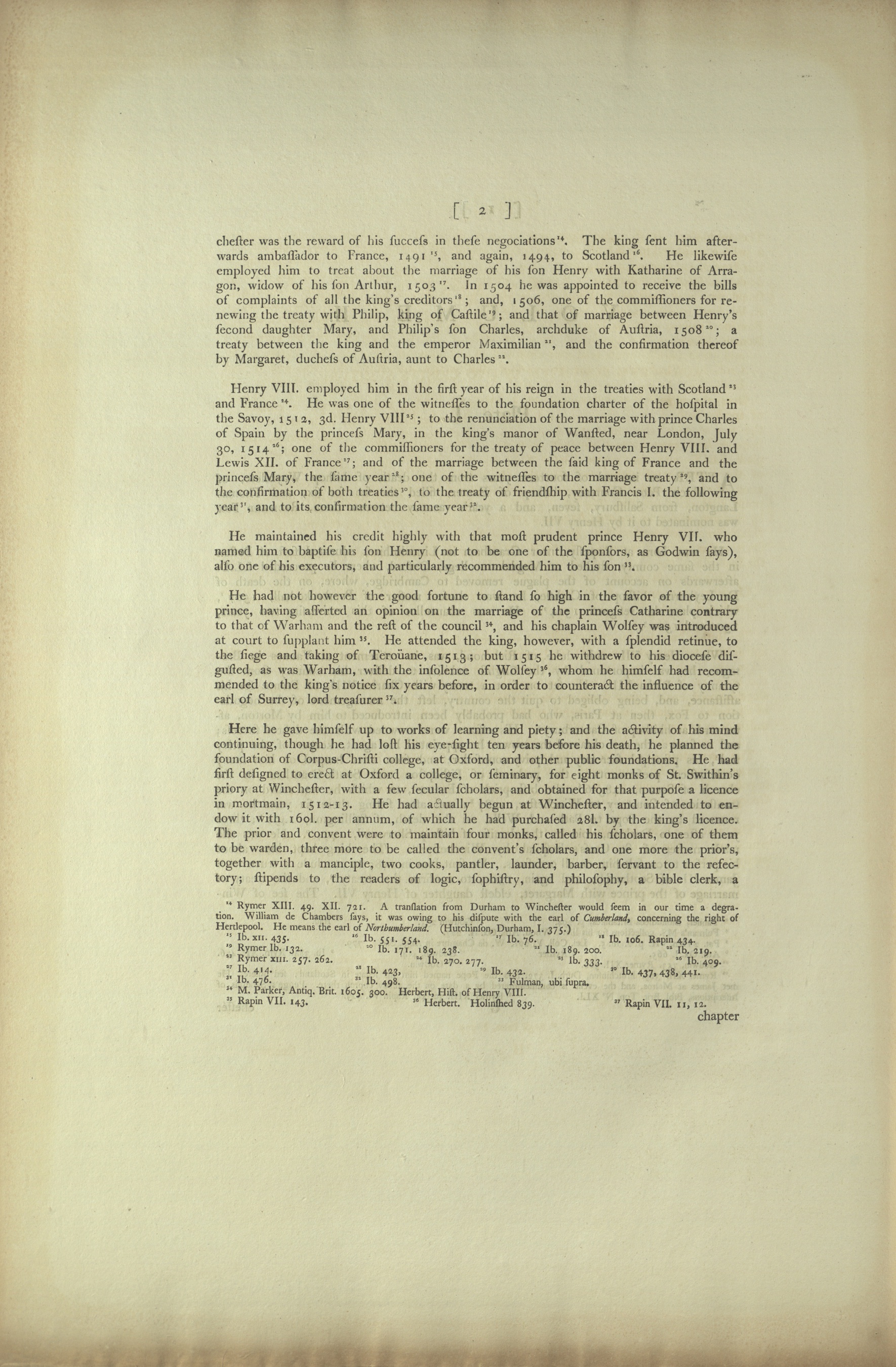
[ (Page) 2 ]
[Win-]chester was the reward of his success in these negotiations14. The king sent him afterwards ambassador of France, 149115, and again, 1494, to Scotland16.
Read more/less…
He likewise employed him to treat about the marriage of his son Henry with Katharine of Arragon, widow of his son Arthur, 150317. In 1504 he was appointed to receive the bills of complaints of all the king’s creditors18; and, 1506, one of the commissioners for renewing the treaty with Philip, king of Castile19; and that of marriage between Henry’s second daughter Mary, and Philip’s son Charles, archduke of Austria, 150820; a treaty between the king and the emperor Maximilian21, and the confirmation thereof by Margaret, duchess of Austria, aunt to Charles22.
Henry VIII. employed him in the first year of his reign in the treaties with Scotland23 and France24. He was one of the witnesses to the foundation charter of the hospital in the Savoy, 1512, 3d. Henry VIII25; to the renunciation of the marriage with prince Charles of Spain by the princess Mary, in the king’s manor of Wansted, near London, July 30, 151426; one of the commissioners for the treaty of peace between Henry VIII. and Lewis XII. of France27; and of the marriage between the said king of France and the princess Mary, the same year28; one of the witnesses to the marriage treaty29, and to the confirmation of both treaties30, to the treaty of friendship with Francis I. the following year31, and to its confirmation the same year32.
He maintained his credit highly with that most prudent prince Henry VII. who named him to baptise his son Henry (not to be one of the sponsors, as Godwin says), also one of his executors, and particularly recommended him to his son33.
He had not however the good fortune to stand so high in the favor of the young prince, having asserted an opinion on the marriage of the princess Catharine contrary to that of Warham and the rest of the council34, and his chaplain Wolsey was introduced at court to supplant him35. He attended the king, however, with a splendid retinue, to the siege and taking of Teroüane, 1513; but 1515 he withdrew to his diocese disgusted, as was Warham, with the insolence of Wolsey36, whom he himself had recommended to the king’s notice six years before, in order to counteract the influence of the earl of Surrey, lord treasurer37.
Here he gave himself up to works of learning and piety; and the activity of his mind continuing, though he had lost his eye-sight ten years before his death, he planned the foundation of Corpus-Christi college, at Oxford, and other public foundations. He had first designed to erect at Oxford a college, or seminary, for eight monks of St. Swithin’s priory at Winchester, with a few secular scholars, and obtained for that purpose a licence in mortmain, 1512-13. He had actually begun at Winchester, and intended to endow it with 160l. per annum, of which he had purchased 28l. by the king’s licence. The prior and convent were to maintain four monks, called his scholars, one of them to be warden, three more to be called the convent’s scholars, and one more the prior’s, together with a manciple, two cooks, pantler, launder, barber, servant to the refectory; stipends to the readers of logic, sophistry, and philosophy, a bible clerk, a
14 Rymer XIII. 49. XII. 721. A translation from Durham to Winchester would seem in our time a degration. William de Chambers says, it was owing to his dispute with the earl of Cumberland, concerning the right of Hertlepool. He means the earl of Northumberland. (Hutchinson, Durham, I. 375.)
15 Ib. XII. 435.
16 Ib. 551. 554.
17 Ib. 76.
18 Ib. 106. Rapin 434.
19 Rymer Ib. 132.
20 Ib. 171. 189. 238.
21 Ib. 189. 200.
22 Ib. 219.
23 Rymer XIII. 257. 262.
24 Ib. 270. 277.
25 Ib. 333.
26 Ib. 409.
27 Ib. 414.
28 Ib. 423[.]
29 Ib. 432.
30 Ib. 437, 438, 441.
31 Ib. 476.
32 Ib. 498.
33 Fulman, ubi supra.
34 M. Parker, Antiq. Brit. 1605. 300. Herbert, Hist. of Henry VIII.
35 Rapin VII. 143.
36 Herbert. Holinshed 839.
37 Rapin VII. 11, 12.
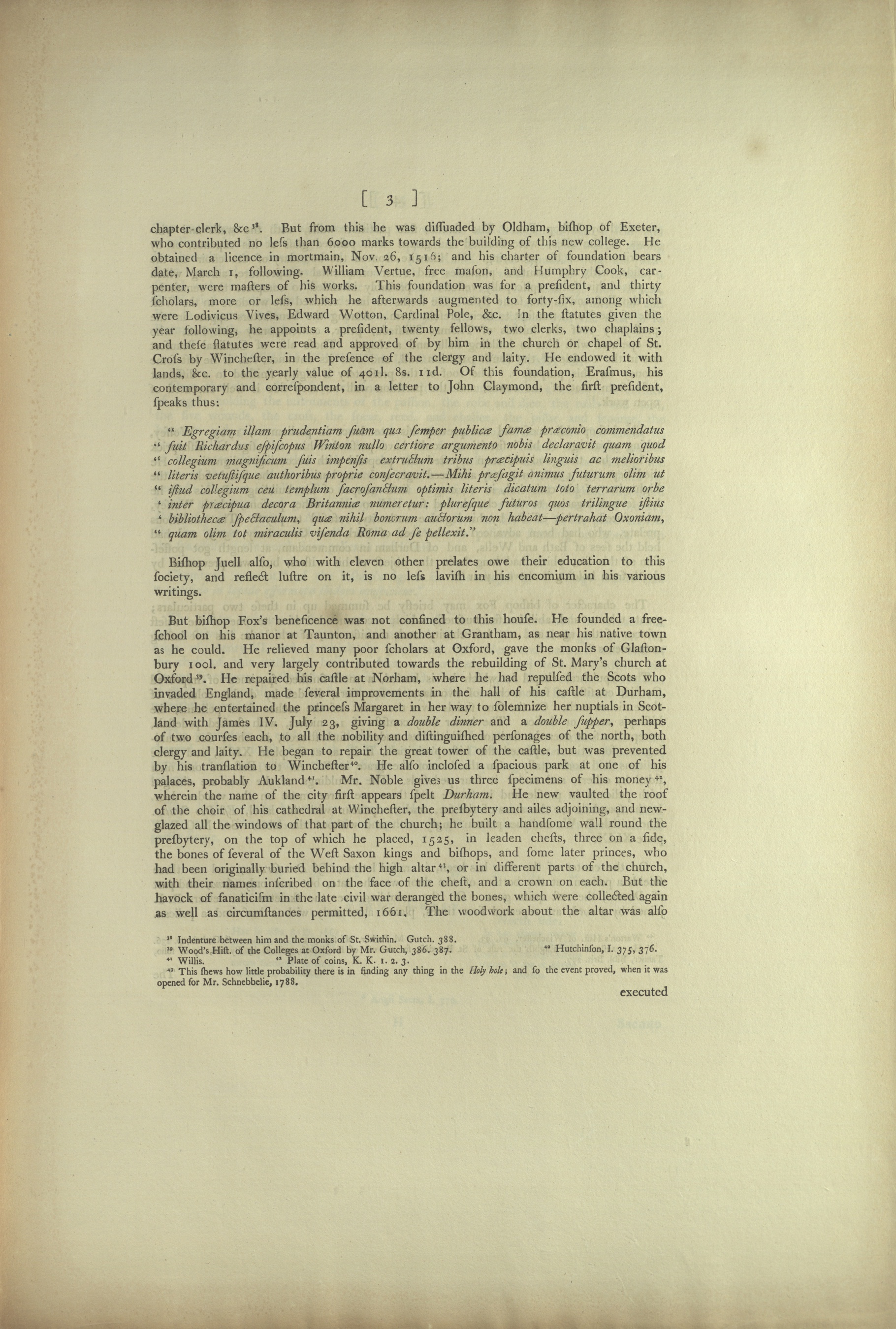
[ (Page) 3 ]
chapter-clerk, &c38. But from this he was dissuaded by Oldham, bishop of Exeter, who contributed no less than 6000 marks towards the building of this new college. He obtained a licence in mortmain, Nov. 26, 1516; and his charter of foundation bears date, March 1, following.
Read more/less…
William Vertue, free mason, and Humphry Cook, carpenter, were masters of his works. This foundation was for a president, and thirty scholars, more or less, which he afterwards augmented to forty-six, among which were Lodivicus Vives, Edward Wotton, Cardinal Pole, &c. In the statutes given the year following, he appoints a president, twenty fellows, two clerks, two chaplains; and these statutes were read and approved of by him in the church or chapel of St. Cross by Winchester, in the presence of the clergy and laity. He endowed it with lands, &c. to the yearly value of 401l. 8s. 11d. Of this foundation, Erasmus, his contemporary and correspondent, in a letter to John Claymond, the first president, speaks thus:
“Egregiam illam prudentiam suam qua semper publicae famae praeconio commendatus fuit Richardus espiscopus [sic] Winton nullo certiore argumento nobis declaravit quam quod collegium magnificum suis impensis extructum tribus praecipuis linguis ac melioribus literis vetustisque authoribus proprie consecravit.—Mihi praesagit animus futurum olim ut istud collegium ceu templum sacrosanctum optimis literis dicatum toto terrarum orbe inter praecipua decora Britanniae numeretur: pluresque futuros quos trilingue istius bibliothecae spectaculum, quae nihil bonorum auctorum non habeat—pertrahat Oxoniam, quam olim tot miraculis visenda Roma ad se pellexit.” [see end of document for translation]
Bishop Juell also, who with eleven other prelates owe their education to this society, and reflect lustre on it, is no less lavish in his encomium in his various writings.
But bishop Fox’s beneficence was not confined to this house. He founded a free-school on his manor at Taunton, and another at Grantham, as near his native town as he could. He relieved many poor scholars at Oxford, gave the monks of Glastonbury 100l. and very largely contributed towards the rebuilding of St. Mary’s church at Oxford39. He repaired his castle at Norham, where he had repulsed the Scots who invaded England, made several improvements in the hall of his castle at Durham, where he entertained the princess Margaret in her way to solemnize her nuptials in Scotland with James IV. July 23, giving a double dinner and double supper, perhaps of two courses each, to all the nobility and distinguished personages of the north, both clergy and laity. He began to repair the great tower of the castle, but was prevented by his translation to Winchester40. He also inclosed a spacious park at one of his palaces, probably Aukland41. Mr. Noble gives us three specimens of his money42, wherein the name of the city first appears spelt Durham. He new vaulted the roof of the choir of his cathedral at Winchester, the presbytery and ailes adjoining, and new-glazed all the windows of that part of the church; he built a handsome wall round the presbytery, on the top of which he placed, 1525, in leaden chests, three on a side, the bones of several of the West Saxon kings and bishops, and some later princes, who had been originally buried behind the high altar43, or in different parts of the church, with their names inscribed on the face of the chest, and a crown on each. But the havock of fanaticism in the late civil war deranged the bones, which were collected again as well as circumstances permitted, 1661. The woodwork about the altar was also
38 Indenture between him and the monks of St. Swithin. Gutch. 388.
39 Wood’s Hist. of the Colleges at Oxford by Mr. Gutch, 386. 387.
40 Hutchinson, I. 375, 376.
41 Willis.
42 Plate of coins, K. K. 1. 2. 3.
43 This shews how little probability there is in finding any thing in the Holy hole; and so the event proved, when it was opened for Mr. Schnebbelie, 1788.
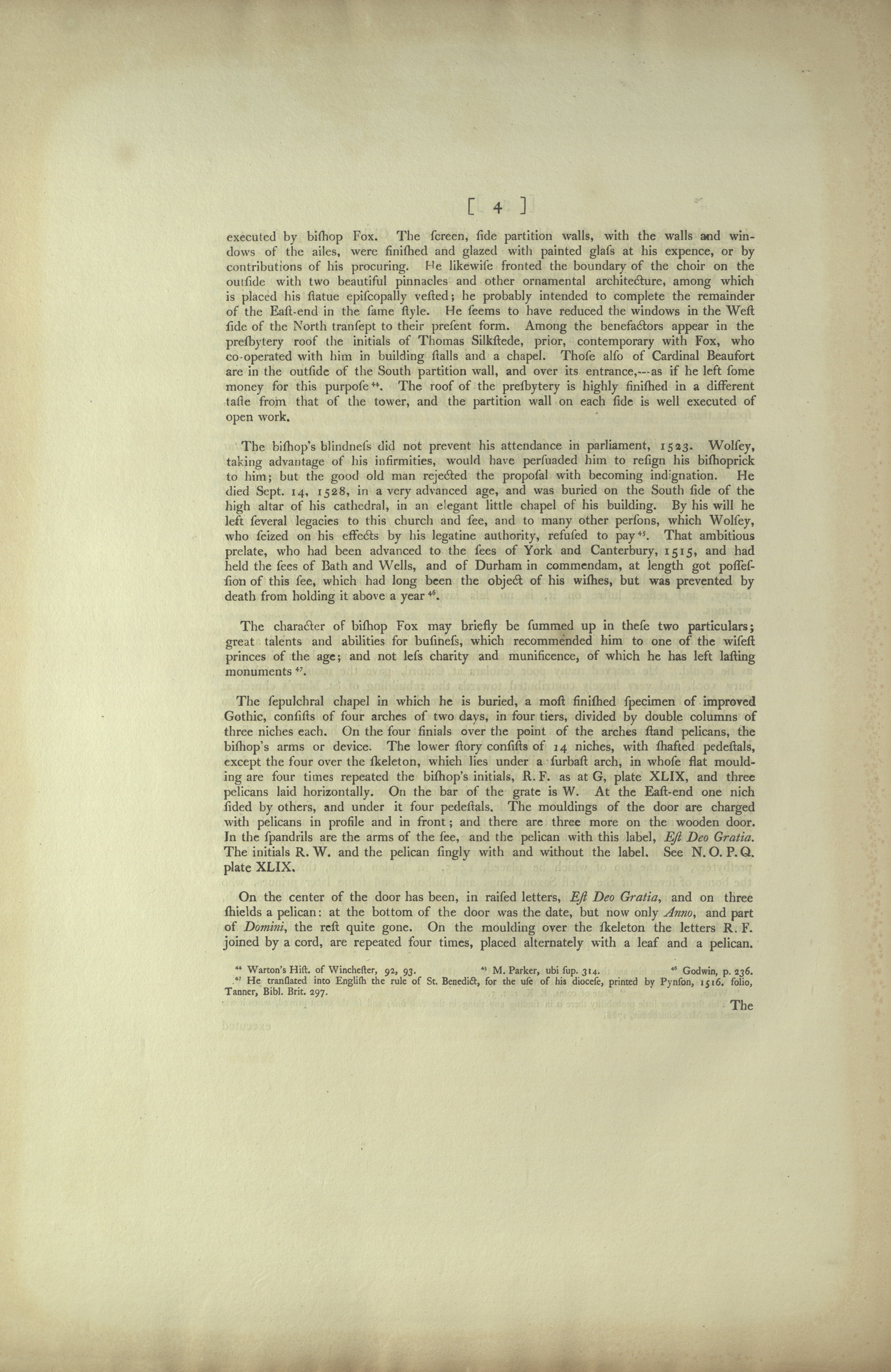
[ (Page) 4 ]
executed by bishop Fox. The screen, side partition walls, with the walls and windows of the ailes, were finished and glazed with painted glass at his expence, or by contributions of his procuring.
Read more/less…
He likewise fronted the boundary of the choir on the outside with two beautiful pinnacles and other ornamental architecture, among which is placed his statue episcopally vested; he probably intended to complete the remainder of the East-end in the same style. He seems to have reduced the windows in the West side of the North transept to their present form. Among the benefactors appear in the presbytery roof the initials of Thomas Silkstede, prior, contemporary with Fox, who co-operated with him in building stalls and a chapel. Those also of Cardinal Beaufort are in the outside of the South partition wall, and over its entrance,—as if he left some money for this purpose44. The roof of the presbytery is highly finished in a different taste from that of the tower, and the partition wall on each side is well executed of open work.
The bishop’s blindness did not prevent his attendance in parliament, 1523. Wolsey, taking advantage of his infirmities, would have persuaded him to resign his bishoprick to him; but the good old man rejected the proposal with becoming indignation. He died Sept. 14, 1528, in a very advanced age, and was buried on the South side of the high altar of his cathedral, in an elegant little chapel of his building. By his will he left several legacies to this church and see, and to many other persons, which Wolsey, who seized on his effects by his legatine authority, refused to pay45. That ambitious prelate, who had been advanced to the sees of York and Canterbury, 1515, and had held the sees of Bath and Wells, and of Durham in commendam, at length got possession of this see, which had long been the object of his wishes, but was prevented by death from holding it above a year46.
The character of bishop Fox may briefly be summed up in these two particulars; great talents and abilities for business, which recommended him to one of the wisest princes of the age; and not less charity and munificence, of which he has left lasting monuments47.
The sepulchral chapel in which he is buried, a most finished specimen of improved Gothic, consists of four arches of two days, in four tiers, divided by double columns of three niches each. On the four finials over the point of the arches stand pelicans, the bishop’s arms or device. The lower story consists of 14 niches, with shafted pedestals, except the four over the skeleton, which lies under a surbast arch, in whose flat moulding are four times repeated the bishop’s initials, R.F. as at G, plate XLIX, and three pelicans laid horizontally. On the bar of the grate is W. At the East-end one nich sided by others, and under it four pedestals. The mouldings of the door are charged with pelicans in profile and in front; and there are three more on the wooden door. In the spandrils are the arms of the see, and the pelican with this label, Est Deo Gratia [The God of Grace]. The initials R.W. and the pelican singly with and without the label. See N. O. P. Q. plate XLIX.
On the center of the door has been, in raised letters, Est Deo Gratia, and on three shields a pelican: at the bottom of the door was the date, but now only Anno, and part of Domini, the rest quite gone. On the moulding over the skeleton the letters R.F. joined by a cord, are repeated four times, placed alternately with a leaf and a pelican.
44 Warton’s Hist. of Winchester, 92, 93.
45 M. Parker, ubi sup. 314.
46 Godwin, p. 236.
47 He translated into English the rule of St. Benedict, for the use of his diocese, printed by Pynson, 1516. folio, Tanner, Bibl. Brit. 297.
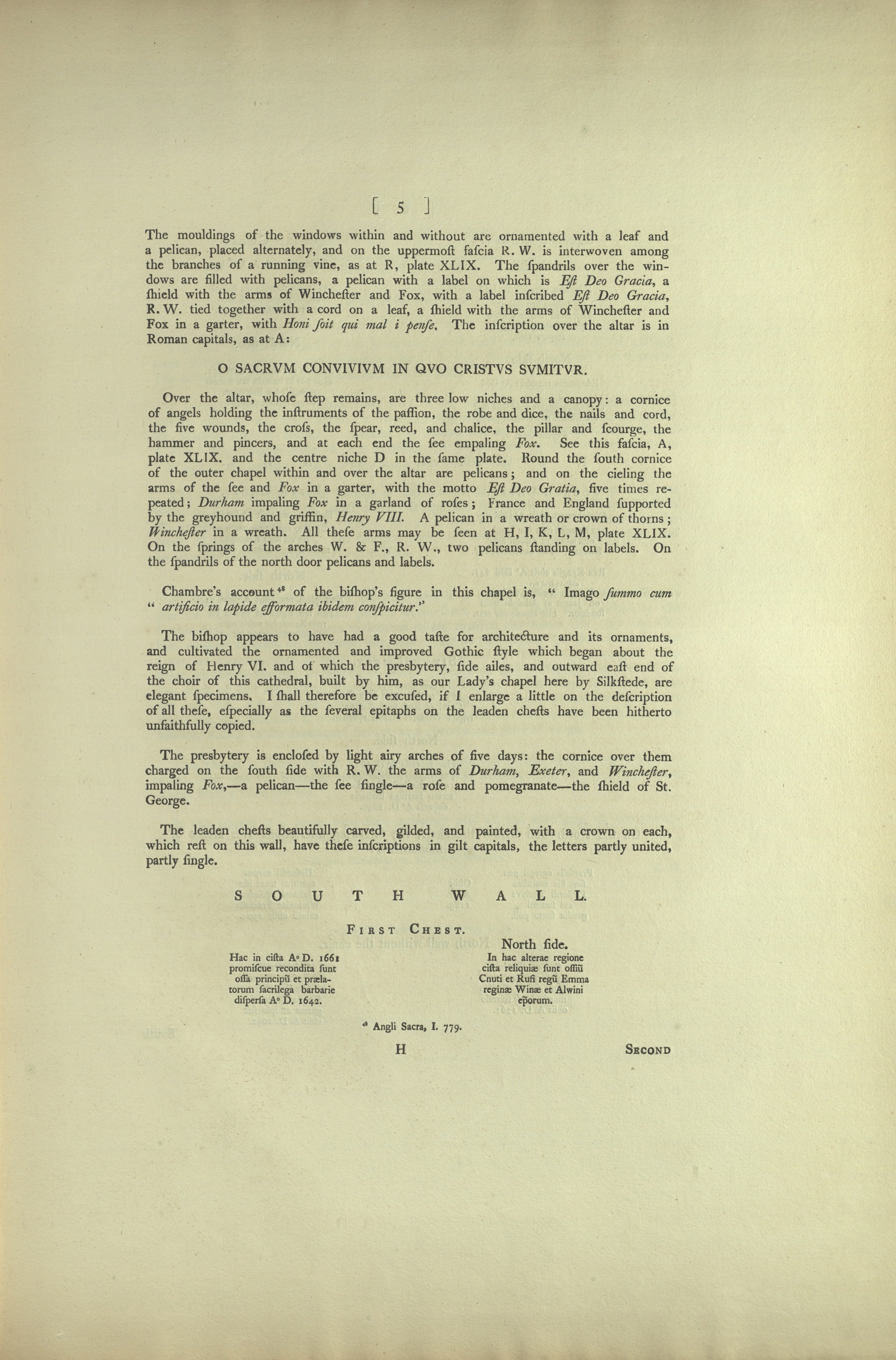
[ (Page) 5 ]
The mouldings of the windows within and without are ornamented with a leaf and a pelican, placed alternately, and on the uppermost fascia R.W. is interwoven among the branches of a running vine, as at R, plate XLIX.
Read more/less…
The spandrils over the windows are filled with pelicans, a pelican with a label on which is Est Deo Gracia [Grace be to God (note that this is also written, further down the page, as Est Deo Gratia)], a shield with the arms of Winchester and Fox, with a label inscribed Est Deo Gracia, R.W. tied together with a cord on a leaf, a shield with the arms of Winchester and Fox in a garter, with Honi soit qui mal i pense [Shamed be whoever thinks ill of it]. The inscription over the altar is in Roman capitals, as at A:
O SACRVM CONVIVIVM IN QVO CRISTVS SVMITVR. [O sacred banquet in which Christ is received.]
Over the alter, whose step remains, are three low niches and a canopy: a cornice of angels holding the instruments of the passion, the robe and dice, the nails and cord, the five wounds, the cross, the spear, reed, and chalice, the pillar and scourge, the hammer and pincers, and at each end the see empaling Fox. See this fascia, A, plate XLIX. and the centre niche D in the same plate. Round the south cornice of the outer chapel within and over the altar are pelicans; and on the cieling [sic] the arms of the see and Fox in a garter, with the motto Est Deo Gratia, five times repeated; Durham impaling Fox in a garland of roses; France and England supported by the greyhound and griffin, Henry VIII. A pelican in a wreath or crown of thorns; Winchester in a wreath. All these arms may be seen at H, I, K, L, M, plate XLIX. On the springs of the arches W. & F., R. W., two pelicans standing on labels. On the spandrils of the north door pelicans and labels.
Chambre’s account48 of the bishop’s figure in this chapel is, “Imago summo cum artificio in lapide efformata ibidem conspicitur.” [His image, fashioned with the highest artistry in stone, can be seen there.]
The bishop appears to have had a good taste for architecture and its ornaments, and cultivated the ornamented and improved Gothic style which began about the reign of Henry VI. and of which the presbytery, side ailes, and outward east end of the choir of this cathedral, built by him, as our Lady’s chapel here by Silkstede, are elegant specimens. I shall therefore be excused, if I enlarge a little on the description of all these, especially as the several epitaphs on the leaden chests have been hitherto unfaithfully copied.
The presbytery is enclosed by light airy arches of five days: the cornice over them charged on the south side with R.W. the arms of Durham, Exeter, and Winchester, impaling Fox,—a pelican—the see single—a rose and pomegranate—the shield of St. George.
The leaden chests beautifully carved, gilded, and painted, with a crown on each, which rest on this wall, have these inscriptions in gilt capitals, the letters partly united, partly single.
S O U T H W A L L.
FIRST CHEST.
North side.
Hac in cista AoD. 1661 In hac alterae regione
promiscue recondita sunt cista reliquiae sunt offiũ
ossa principũ et praela- Cnuti et Rufi regũ Emma
torum sacrilega barbarie reginae Winae et Alwini
dispersa AoD. 1642. ep̃orum.
[see end of document for translation]
48 Angli Sacra, I. 779.
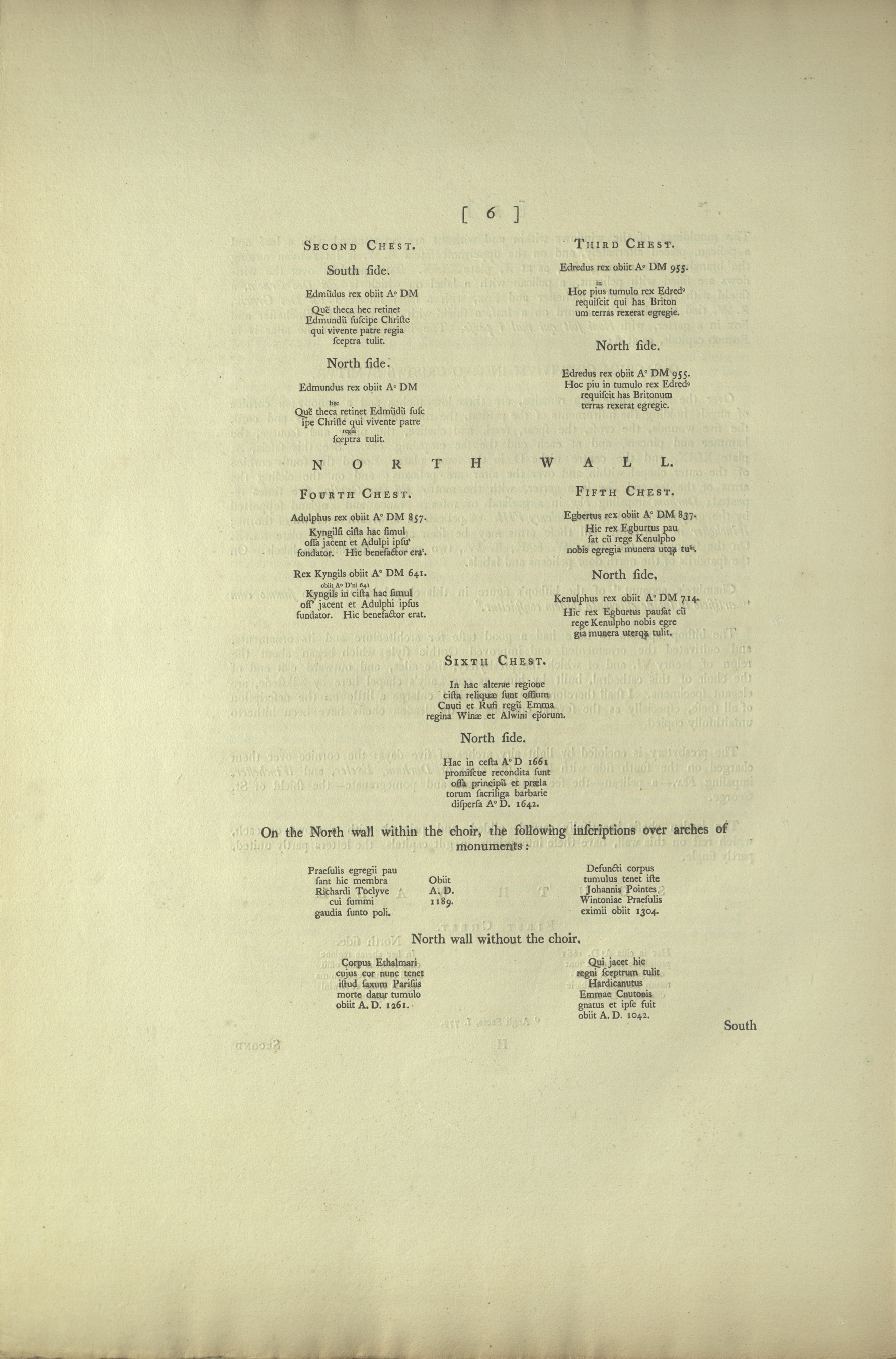
[ (Page) 6 ]
Due to the formatting of this text, no preview is available. Click "Read more/less" below, then scroll down to view text for page 6.
Read more/less…
SECOND CHEST. THIRD CHEST.
South Side. Edredus rex obiit Ao DM 955.
Edmũdus rex obiit Ao DM Hoc inpius tumulo rex Edred9
requiscit qui has Briton
Quẽ theca hec retinet um terras rexerat egregie.
Edmundũ suscipe Christe
qui vivente patre regia
sceptra tulit.
North Side.
North Side. Edredus rex obiit Ao DM 955.
Hoc piu in tumulo rex Edred9
Edmundus rex obiit Ao DM requiscit has Britonum
terras rexerat egregie.
Quẽ hectheca retinet Edmũndũ susc
ipe Christe qui vivente patre
regiasceptra tulit.
N O R T H W A L L.
Hac in cista AoD. 1661 In hac alterae regione
FOURTH CHEST. FIFTH CHEST.
Adulphus rex obiit Ao DM 857. Egbertus rex obiit Ao DM 837.
Kyngilsi cista hac simul Hic rex Egburtus pau
ossa jacent et Adulpi ipsu3 sat cũ rege Kenulpho
fondator. Hic benefactor erat. nobis egregia munera utq tulit.
Rex Kyngils obiit Ao DM 641. North Side.
obiit Ao D’ni 641
Kyngils in cista hac simul Kenulphus rex obiit Ao DM 714.
oss’ jacent et Adulphi ipsus Hic rex Egburtus pausat cũ
fundator. Hic benefactor erat. rege Kenulpho nobis egre
gia munera uterq tulit.
SIXTH CHEST.
In hac alterae regione
cista reliquae sunt ossium
Cnuti et Rufi regũ Emma
regina Winae et Alwini ep̃orum.
North Side.
Hac in cesta AoD. 1661
promiscue recondita sunt
ossa principũ et praela
torum sacriliga barbarie
dispersa AoD. 1642.
On the North wall within the choir, the following inscriptions over arches of monuments:
Praesulis egregii pau Defuncti corpus
sant hic membra . . . Obiit tumulus tenet iste
Richardi Toclyve . . . A.D. Johannis Pointes
cui summi . . . . 1189. Wintoniae Praesulis
gaudia sunto poli. eximii obiit 1304.
North wall without the choir.
Corpus Ethalmari Qui jacet hic
cujus cor nunc tenet regni sceptrum tulit
istud saxum Parisiis Hardicanutus
morte datur tumulo Emmae Cnutonis
obiit A.D. 1261. gnatus et ipse fuit
obiit A.D. 1042.
[see end of document for translation]
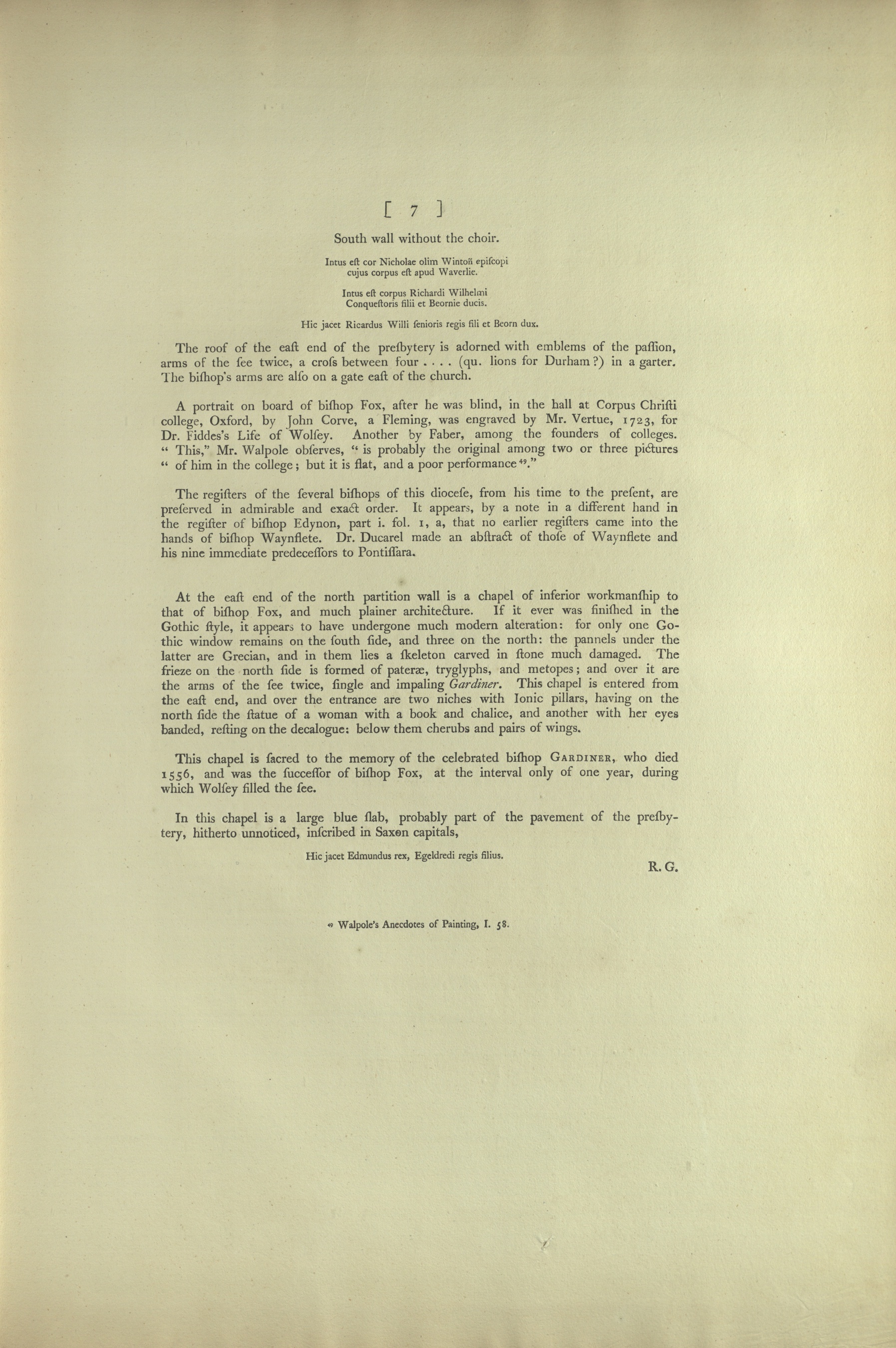
[ (Page) 7 ]
Due to the formatting of this text, no preview is available. Click "Read more/less" below to view text for page 7.
Read more/less…
South wall without the choir.
Intus est cor Nicholae olim Wintoñ episcopi
cujus corpus est apud Waverlie.
Intus est corpus Richardi Wilhelmi
Conquestoris filii et Beornie ducis.
Hic jacet Ricardus Willi senioris regis fili et Beorn dux.
[see end of document for translation]
The roof of the east end of the presbytery is adorned with emblems of the passion, arms of the see twice, a cross between four . . . . (qu. lions for Durham?) in a garter. The bishop’s arms are also on a gate east of the church.
A portrait on board of bishop Fox, after he was blind, in the hall at Corpus Christi college, Oxford, by John Corve, a Fleming, was engraved by Mr. Vertue, 1723, for Dr. Fiddes’s Life of Wolsey. Another by Faber, among the founders of colleges. “This,” Mr. Walpole observes, “is probably the original among two or three pictures of him in the college; but it is flat, and a poor performance49.”
The registers of the several bishops of this diocese, from his time to the present, are preserved in admirable and exact order. It appears, by a note in a different hand in the register of bishop Edynon, part i. fol. I, a, that no earlier registers came into the hands of bishop Waynflete. Dr. Ducarel made an abstract of those of Waynflete and his nine immediate predecessors to Pontissara.
At the east end of the north partition wall is a chapel of inferior workmanship to that of bishop Fox, and much plainer architecture. If it ever was finished in the Gothic style, it appears to have undergone much modern alteration: for only one Gothic window remains on the south side, and three on the north: the pannels under the latter are Grecian, and in them lies a skeleton carved in stone much damaged. The frieze on the north side is formed of paterae, tryglyphs, and metopes; and over it are the arms of the see twice, single and impaling Gardiner. This chapel is entered from the east end, and over the entrance are two niches with Ionic pillars, having on the north side the statue of a woman with a book and chalice, and another with her eyes banded, resting on the decalogue: below them cherubs and pairs of wings.
This chapel is sacred to the memory of the celebrated bishop GARDINER, who died 1556, and was the successor of bishop Fox, at the interval only of one year, during which Wolsey filled the see.
In this chapel is a large blue slab, probably part of the pavement of the presbytery, hitherto unnoticed, inscribed in Saxon capitals,
Hic jacet Edmundus rex, Egeldredi regis filius. [Here lies King Edmund, son of King Egelred.]
R.G. [Richard Gough]
49Walpole’s Anecdotes of Painting, I. 58.
Translations of the Longer Passages:
Plate L, Page 3 [p. 21 of the set], lines 14-21: He has displayed to us that singular prudence of his, for which he, Richard, bishop of Winchester, has always enjoyed public commendation, by no more certain proof than that he has consecrated on his own initiative (or “on his own” or “suitably”) and built at his own expense a magnificent college for the three principal languages and their superior literatures and ancient authors. My mind foresees that one day that college, like a holy temple dedicated to the finest literature, will be counted throughout the whole world among the chief beauties of Britain; that the wonder of its trilingual library, which should not lack good authors, will draw a great many to Oxford, as Rome once lured them to herself to behold her wonders.
Plate L, Page 5 [p. 23 of the set], lines 40-45: SOUTH WALL. FIRST CHEST. In this chest, A.D. 1661, were buried together indiscriminately the bones of princes and prelates, which had been scattered because of sacrilegious heathenism (or “barbarity”). North Side. In this chest [and] the other facing it (or “on the opposite side”) are the remains of the bones of kings Cnut and Rufus, queen Emma, bishops Wina and Alwin.
Plate L, Page 6, [p. 24 of the set]: SECOND CHEST. South Side. King Edmund died A.D., whom this chest contains. Christ, receive Edmund, who bore the royal scepter while his father was alive. (This is also the translation of the North Side transcription.) THIRD CHEST. South Side. King Edred died A.D. 955. In this tomb rests pious king Edred, who had most nobly ruled these lands of the Britons. (This is also the translation of the North Side transcription.)
NORTH WALL. FOURTH CHEST. King Adulph died A.D. 857. In this chest lie together the bones of Kyngils and Adulph, the former the founder. The latter was the benefactor. King Kyngils died A.D. 641. In this chest lie together the bones of Kyngils and Adulph, the former the founder. The latter was the benefactor. FIFTH CHEST. King Egbert died A.D. 837. Here King Egbert rests with King Kenulph. Each bestowed exceptional gifts upon us. North side. King Kenulph died A.D. 714. Here King Egbert rests with King Kenulph. Each bestowed exceptional gifts upon us.
SIXTH CHEST. In this chest [and] the other facing it (or “on the opposite side”) are the remains of the bones of kings Cnut and Rufus, queen Emma, bishops Wina and Alwin. North side. In this chest, A.D. 1661, were buried together indiscriminately the bones of princes and prelates, which had been scattered because of sacrilegious heathenism (or “barbarity”).
On the North wall within the choir, the following inscriptions over arches of monuments: Here rest the limbs of the eminent bishop Richard Toclyve, upon whom may there be the joys of heaven above. He died A.D. 1189. This tomb contains the body of John of Pontoise, eminent bishop of Winchester. He died 1304.
North wall without the choir. The body of Ethelmar, whose heart this stone now contains, has (lit. “is given”) a tomb in Paris, where he died. He died A.D. 1261. He who lies here, Hardicanute, bore the scepter of the kingdom. He was also son of Emma and Cnut. He died A.D. 1042.
Plate L, Page 7 [p. 25 of the set], lines 2-6: Inside is the heart of Nicholas, formerly bishop of Winchester, whose body is at Waverly. Inside is the body of Richard, son of William, the Conqueror and Duke of Bearland. Here lies Richard, son of king William the elder and duke of Bearland.